The post A Gaucho’s Life in San Antonio de Areco appeared first on The Expeditioner Travel Site.
]]>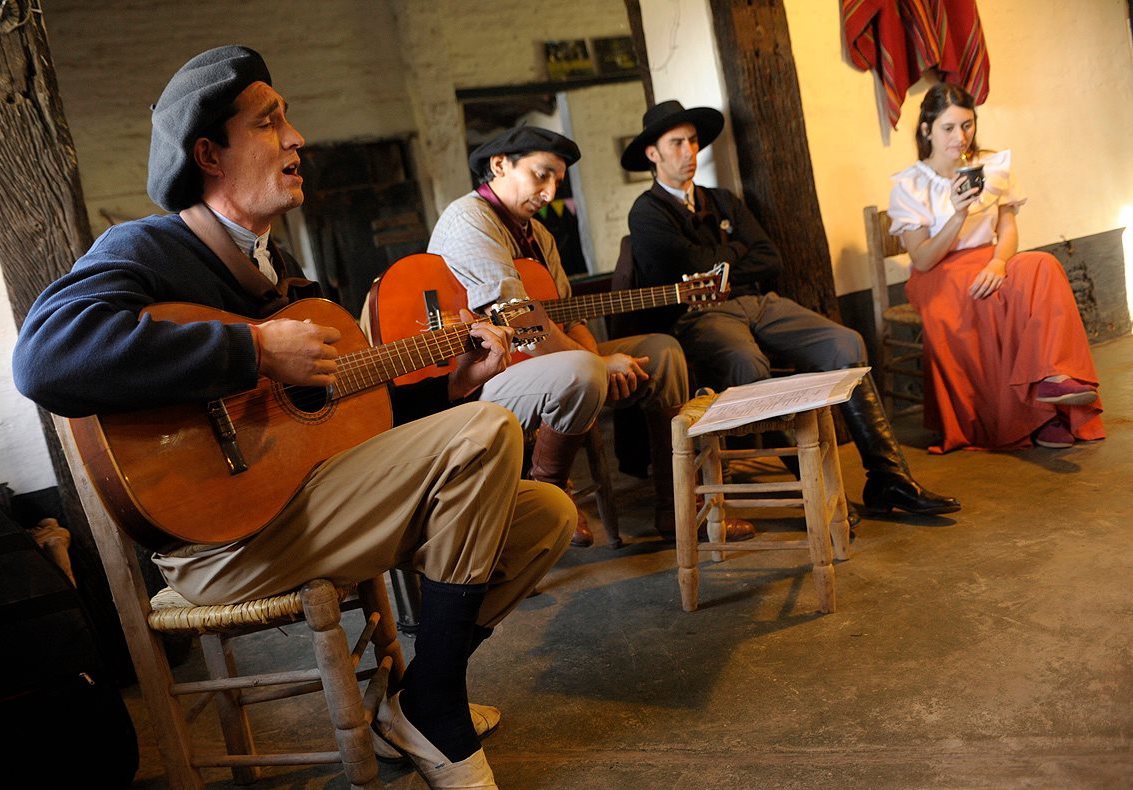
When thinking about Argentina, what comes to mind? Americans will say meat, Europeans will think about football/soccer, and South Americans will mention tango — but locals will talk about the mythical gauchos.
In the middle of the Argentinian Pampas, only a 60 miles from Buenos Aires, stands a little town, to all appearances very quiet, but keen to preserve the country’s habits and customs. San Antonio de Areco was founded in 1730, and it is today probably the town that best symbolizes gauchos’ traditions of the past. For 80 years now, this town has held the Festival of Tradition every November, which is considered to be the oldest celebration in Argentina.
An Origin Dating Back to the 30’s
The origin of the festival is linked to the history of San Antonio de Areco. Located at the edge of the town, along the Camino Real, the Ricardo Güiraldes Museum is one of the unmissable places of interest in Areco. Its name pays tribute to the famous Argentinian writer, poet and novelist Ricardo Güiraldes, whose family owned estancias in San Antonio de Areco.
His popular novel, Don Segundo Sombra, drew inspiration from the way of life of a gaucho arequero (Areco’s dwellers), and was so successful that the mayor of the town at that time decided to establish the Tradition Day in San Antonio de Areco in 1939. This celebration originally took place in Areco and Lujan, a town only a stone’s throw away from Buenos Aires. It was only in 1984 that an ordinance law was adopted and ordered that San Antonio de Areco become permanent headquarters of the Tradition Day.
The first celebration was organized in the main streets of the town in 1939. Only a few horse shows, such as rodeos, were planned. At night, a barbecue (asado in Spanish) was made and traditional dances and authentic folkloric music were performed.
The Festival of Tradition today
Today, the Festival of Tradition is much more than a simple day celebrating traditions of a period kept in old ages. This unique cultural event gathers thousands of gauchos from all over the country, and of all ages and origin. It always takes place the week of November 10 to celebrate the birthday of José Hernandez, Argentinian poet and journalist, especially famous thanks to the poem Martin Fierro, which, just as Don Segundo Sombra, refers to the gauchos’ life in the campo. This date was chosen in order to pay tribute to this literary icon, who devoted his life to defend the gaucho’s identity and his role in the independence of Argentina.
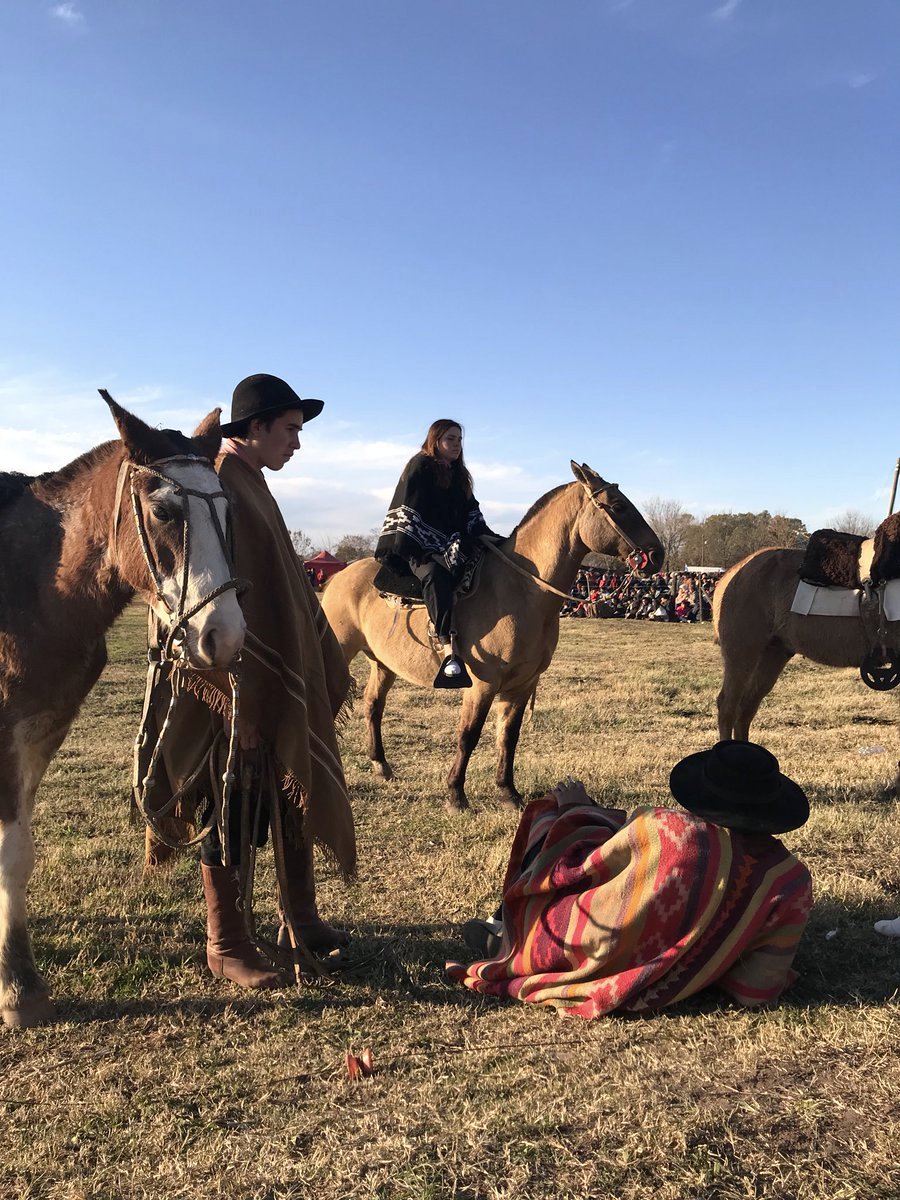
All along the week, interesting exhibitions, captivating concerts and elegant dances are performed at the four sides of the town. During the weekends, horse-riding competitions, horseback games and jineteadas are carried out. Jineteadas refers to rodeos, in the style of South America. The gaucho attempts to stay on a young, wild horse from 6 to 15 seconds. This event is one of the most attended in the festival as it provides gauchos with the opportunity to challenge one another and to prove their strength, dexterity and bravery.
The show’s climax is the parade of gauchos throughout the town. Horsemen and horses get together under the crowd’s applause and march in the cobbled streets of San Antonio de Areco. Today, according to the tradition, the Argentinian flag should be held by Oscar Peyrena, one of the most emblematic gauchos of the province.
The festivities don’t stop when night falls. In the streets, a delicious smell of grilled meat permeates, couples chat and get drinks while rhythmic guitarreadas(folkloric music) play all day and curious travelers listen to the stories told by locals sitting around a bonfire.
Have a walk in the streets of Areco during the Festival of Tradition, and you will be carried away by this surprising festival. Only an hour away from the crush of the capital city, San Antonio de Areco is a journey back in the past and is a good example of the country’s cultural diversity. Peasants, craftsmen, dancers, musicians, artists and gauchos try hard to revive the old local habits, so as to preserve this unique heritage among a population, eager to protect all the legends of Argentina.

/
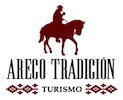 The travel agency Areco Tradicion was created with the idea of introducing a traditional town strongly marked by the gauchos’ footprint: San Antonio de Areco. It was founded in 2013 by Bertrand Mahé, a professional photographer and lover of the large wild Argentinian landscapes and Andrés Ferrante, founder of the Portal Areco, a tourism website about San Antonio de Areco and its surrounding regions. In 2015, Sarah Reynier decided to leave Buenos Aires, where she had been living for two years, and join the team of Areco Tradición in San Antonio de Areco. To learn more about the Festival of Tradition, visit Arecotradicion.com/en/homepage/.
The travel agency Areco Tradicion was created with the idea of introducing a traditional town strongly marked by the gauchos’ footprint: San Antonio de Areco. It was founded in 2013 by Bertrand Mahé, a professional photographer and lover of the large wild Argentinian landscapes and Andrés Ferrante, founder of the Portal Areco, a tourism website about San Antonio de Areco and its surrounding regions. In 2015, Sarah Reynier decided to leave Buenos Aires, where she had been living for two years, and join the team of Areco Tradición in San Antonio de Areco. To learn more about the Festival of Tradition, visit Arecotradicion.com/en/homepage/.
The post A Gaucho’s Life in San Antonio de Areco appeared first on The Expeditioner Travel Site.
]]>The post 10 Hiking Trails Around the World That Will Blow Your Mind appeared first on The Expeditioner Travel Site.
]]>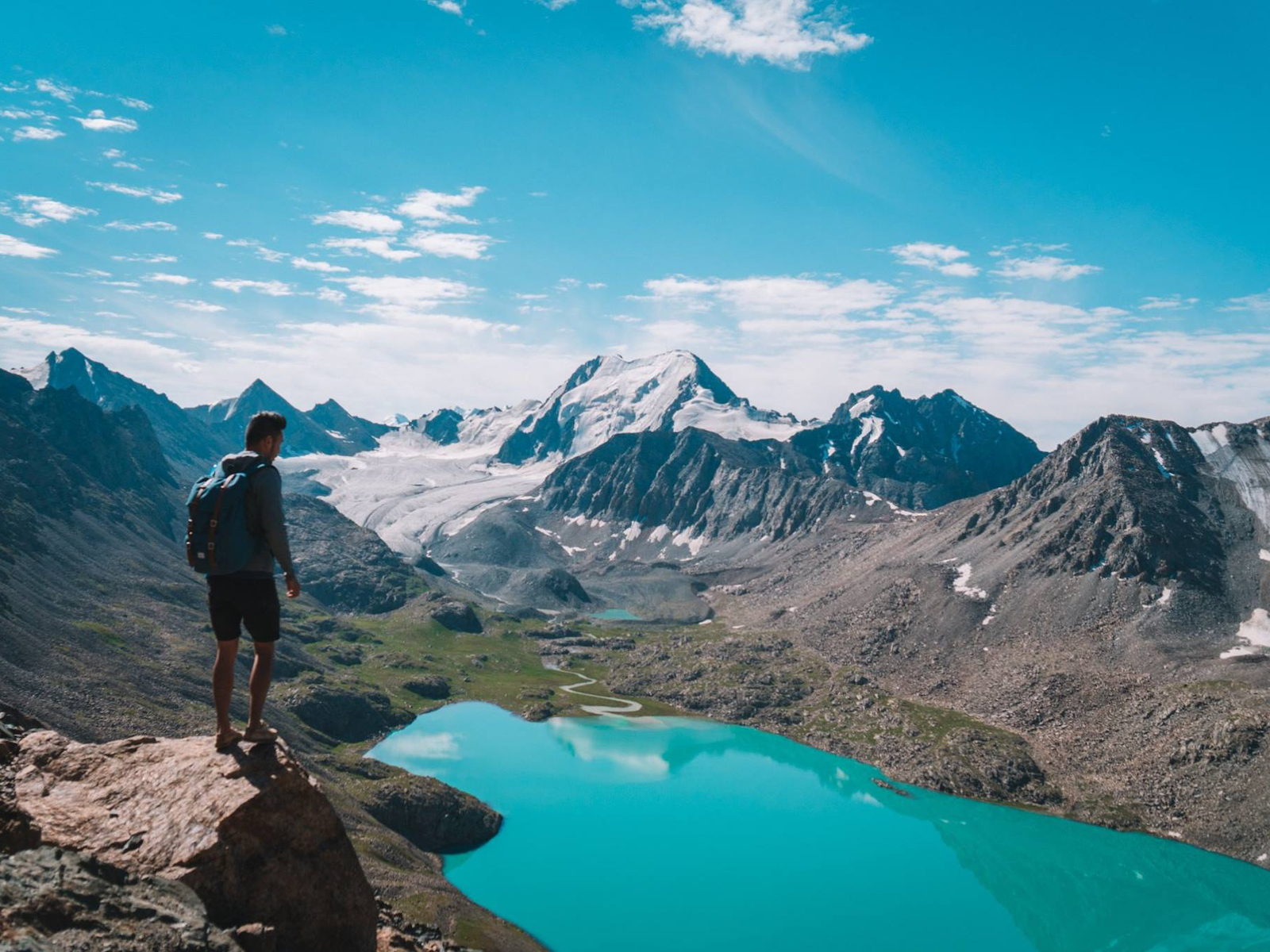
I have always been a nature person. Cities, for me, seem unnecessarily chaotic and at times, overwhelming. Nature, on the other hand, is simple, straightforward in its beauty and comes at no extra cost. There is nothing better than walking in the peacefulness of the mountains, around the calming sound of rocks and rivers, and having the front seat row to Mother Nature. Whenever I have a chance to disconnect from the world and go on a four-day trek in the mountain, I would do so with no hesitation.
I first discovered my love for hiking in 2014 in Nepal, when I decided to go hike the Annapurna Base Camp trail alone with no porter or guide. It was a huge endeavor for me since I never had any previous hiking experience and I never thought of myself as “outdoorsy”. Everything changed after that and now, I tremble with excitement every time I see a trail I could hike into the heart of the mountains.
After 6 years of traveling around the world from Peru to New Zealand, I have compiled a list of my top 10 hiking experience from around the world. The trails lengths range from 6 hours to 7 days, 1,000 meters to 4,700 meters high, and from a stroll to me dragging my feet to the top. Without further ado, let’s begin with my first trek ever.
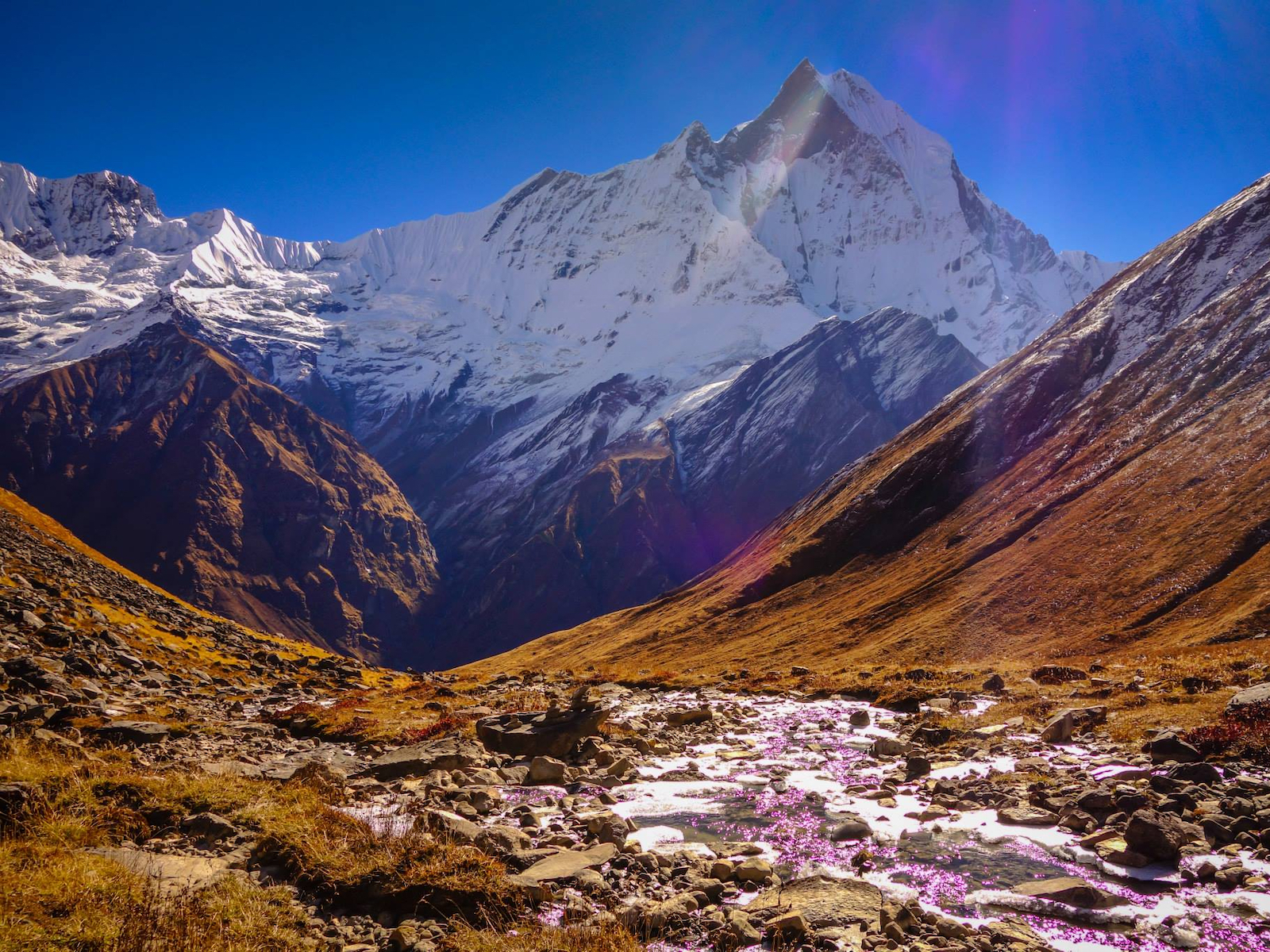
1) Annapurna Base Camp Trek (Nepal)
Location: Pokhara, Nepal
Length: 7 – 10 days return
Highest Altitude: 14,107 feet
Distance: ~75 miles
Difficulty: Moderate
This was my first hike ever and it is still my favorite and most memorable out of all. The trail begins in the beautiful city by the lake with a view of the Himalayas, Pokhara. The trail is considered to be one of the most diverse in Nepal, even more so than the Everest Base Camp trail. You start walking through a lush green forest, going up and down valleys, crossing several massive suspension bridges and through the bamboo forest. Pace yourself past the avalanche-prone valley and eventually you will be surrounded by several 26,000-foot-high peaks of the Himalayas.
Nothing will make you feel accomplished and humbled at the same time as conquering the Annapurna Base Camp trail and still being towered by not one but several higher ones. It’s even more intimidating to know that one of the mountains surrounding you at the base camp, the Annapurna, is one of the least climbed and the deadliest out of all the 26,000-foot peaks with the highest fatality rate at 40.8%. That feeling of accomplishment will be with you for several months to come after.

2) Ala Kul Trek (Kyrgyzstan)
Location: Karakol, Kyrgyzstan
Length: 2 – 4 days return
Highest Altitude: 11,600 feet
Distance: ~33 miles
Difficulty: Moderate
For such a small off-the-beaten-path country, Kyrgyzstan has a lot to offer for nature lovers with stunning canyons, pristine alpine lakes and plenty of hiking trails, all tucked away in the unexplored mountain range of Central Asia. One of that trail is the Ala Kul trail, a two to four-day hike that starts from the city of Karakol. This route will take you through one of the most stunning forests rich with vegetation and wildlife, then you get to camp under the stars at Ala Kul Lake. The best way to end this three-day hiking trip is to make your way down to Altyn Arashan, where you can soak in a nice natural hot spring.
The highlight of this trek though, is the Ala Kul Lake. You will have to hike along the side of a mountain passing the lake to the 11,600-foot-high pass and from there, you will be rewarded with a panoramic view of this alpine lake and the mountains behind it.

3) Grand Balcon Sud and Lac Blanc Trails (France)
Location: Chamonix, France
Length: 8 – 10 hours return
Highest Altitude: 7,716 feet
Distance: ~9.3 miles
Difficulty: Moderate but Long
The French Alps offer hikers plenty of opportunities to get lost in nature for a few hours with several trails for both single and multi-day hikers. One of my favorite single-day hikes is a combination of the Grand Balcon Sud trail and the Lac Blanc trail. The Grand Balcon Sud trail will take you up and along the side of the mountain overlooking the city of Chamonix and Mont Blanc. Throughout the trail, you will be rewarded with the beautiful jagged peaks on your right and colorful vegetation and wildlife on your left. If you are lucky, you might be able to witness the Chamois like I did when I was hiking up the Grand Balcon Sud trail in the early morning.
Towards the end of the Grand Balcon Sud trail, you can continue on the Lac Blanc trail to see the White Lake where the magic of this trail is. If the weather is calm enough when you arrive at the lake, you will be rewarded with a perfect reflection of the French Alps on the lake. It was quite a sight to behold.
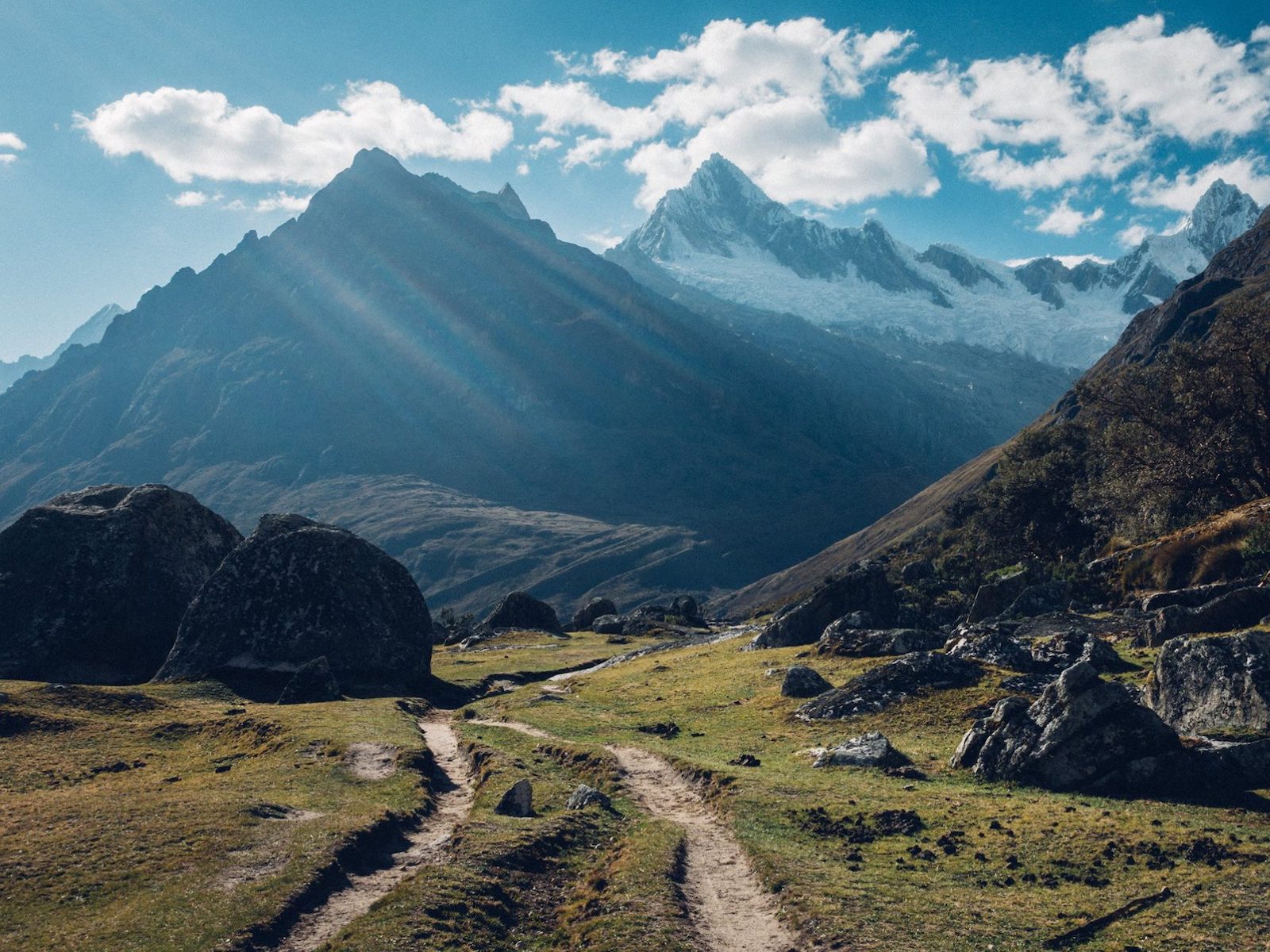
4) Santa Cruz Trek (Peru)
Location: Huaraz, Peru
Length: 3 – 4 days return
Highest Altitude: 15,583 feet
Distance: ~22.3 miles
Difficulty: Moderate
Huaraz in the north of Peru is one of my favorite places on Earth. I spent almost twoeeks alone in this city, exploring some of the best trails in the Cordillera Blanca mountain range. When people come to Peru, they always head for the south for the Inca trail and call it a day. What they don’t realize is that the true beauty of Peruvian mountains lies in the North, in Huaraz.
One of the treks I did was the Santa Cruz trek. I spent four days hiking in the solitude of the Cordillera Blanca mountain range through a beautiful canyon, stunning valleys and a pristine blue lake that serves as a great spot for camping. You will pass through one of the most beautiful scenery you will ever see in your life, sleep under the shadow of the towering Taulliraju mountain and be rewarded with a panoramic view of the mountain at its highest point of Punta Union Pass.
The experience of hiking this trail alone, carrying all my gear and food for four days, made it even more challenging and left me in awe for the rest of my trip in South America.
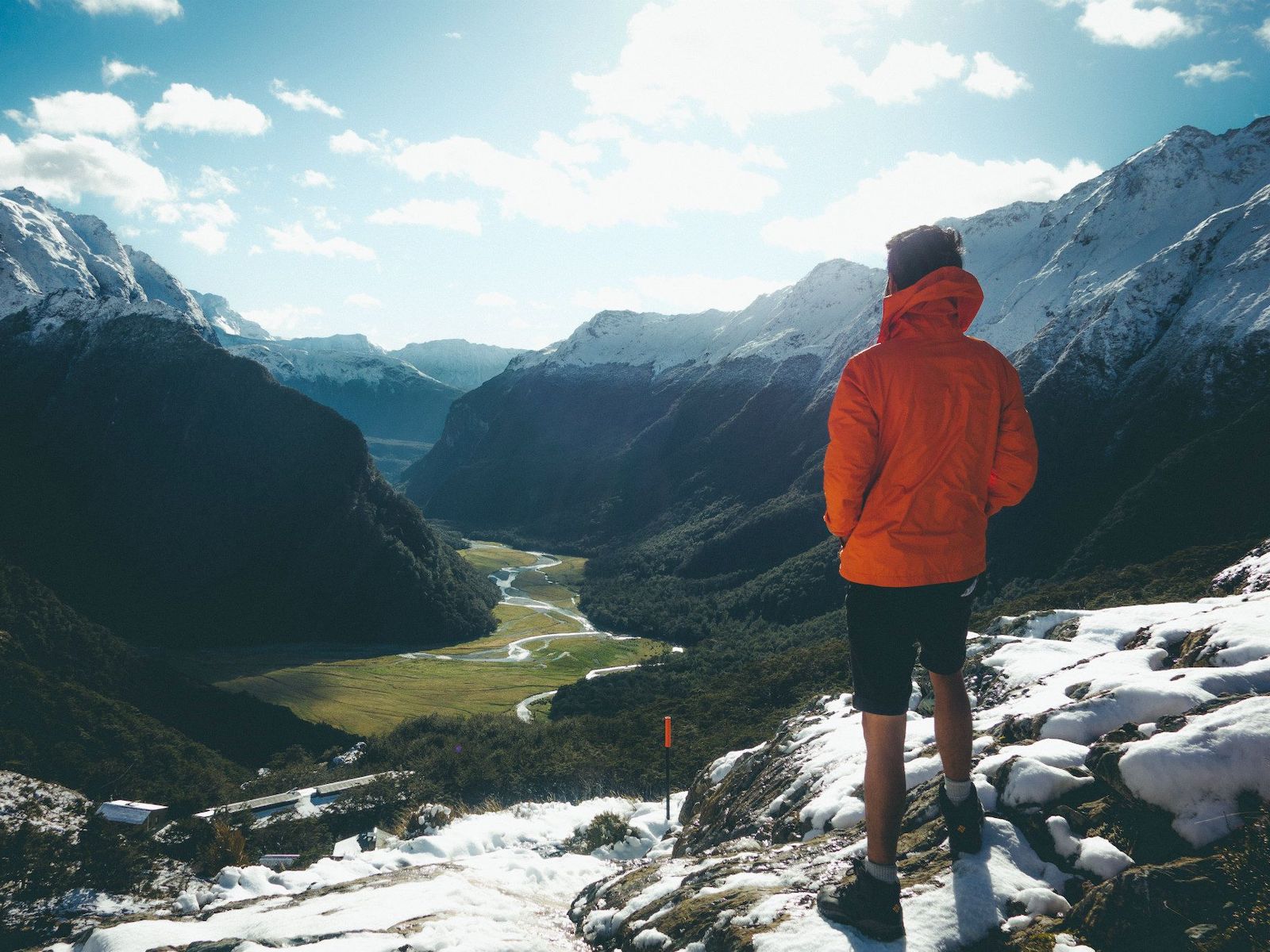
5) Routeburn Track (New Zealand)
Location: Te Anau, New Zealand
Length: 3 – 4 days return
Highest Altitude: 4,117 feet
Distance: ~20 miles
Difficulty: Easy
The Routeburn Track is one of New Zealand’s best great walks and for good reasons. The trail is located in the beautiful South Island starting near Te Anau and ends near Queenstown.
The trail will take you to the Key Summit on your first day, back down to sleep by the MacKenzie Lake, passing through the valley along the exposed Hollyford Face with expansive views over the Darran Mountains. Then it’s up to the Harris Saddle Shelter before coming down to Routeburn Falls Hut for your last night.
Your last day will be a casual walk down through the stunning beech forest, with a view of the Humboldt Mountains and ending at Routeburn Flats Hut. The Routeburn Track sure is an action-packed trail for you to do in New Zealand.
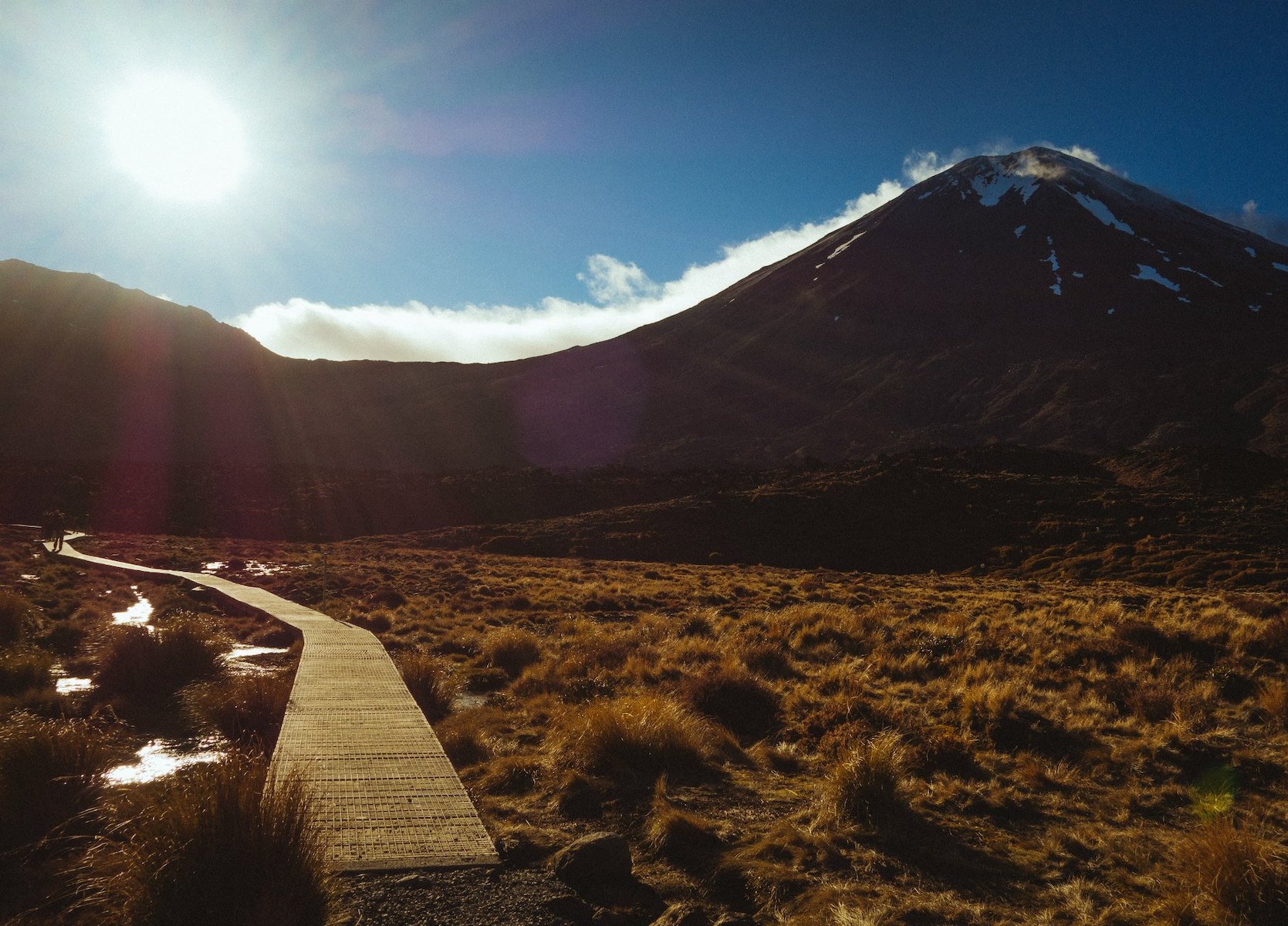
6) Tongariro Crossing (New Zealand)
Location: Lake Taupo, New Zealand
Length: 5 – 7 hrs return
Highest Altitude: 3,674 feet – 7,516 feet
Distance: ~ 12 miles
Difficulty: Easy to Moderate
Another great trail in New Zealand is the Tongariro Crossing trail, located in the North Island of the country near Lake Taupo. Like most trails in New Zealand, the Tongariro Crossing trail has a well-paced climb with casual walk up and steep parts all scattered throughout equally.
Starting from the Mangatepopo Valley, you will go through a series of gradual and steep climbs until you reach the saddle between Mount Tongariro and Mount Ngauruhoe. From here you can take a side trip like I did to go up Mount Ngauruhoe or to Mount Doom for Lord of the Rings fan. The trip will take two extra hours to do so but you will get a stunning view of the crossing in one whole swoop.
From the saddle, you will have to go through the South Crater before climbing again to the Red Crater. You will be able to see two lakes from up there, one in emerald green and the other in pristine blue. When you pass all the lakes, you will then have to zigzag your way past Ketetahi Shelter and down to the end of the trails.
The scenery is so diverse, it will have you thinking you were trekking for several days instead of five to seven hours.
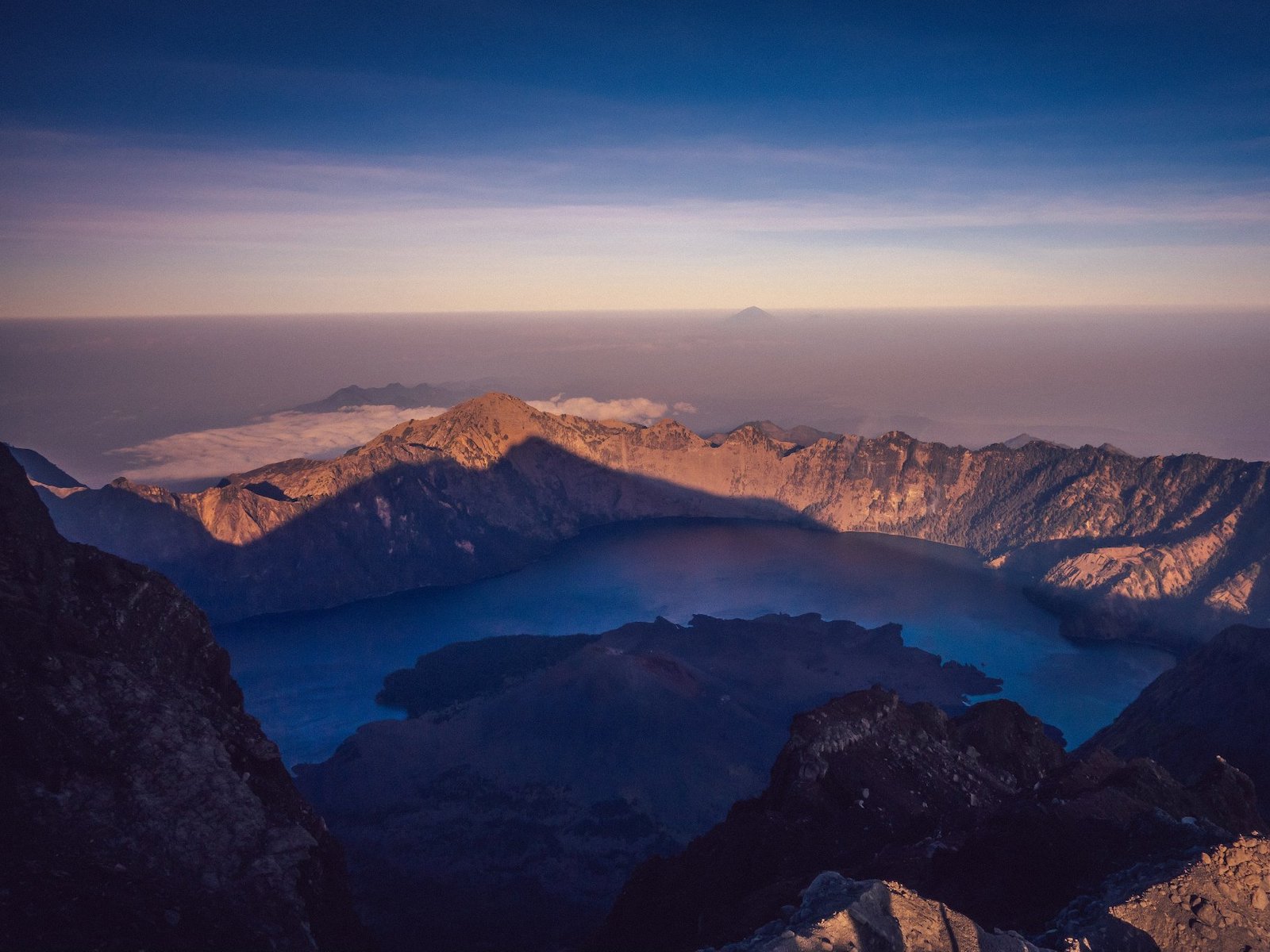
7) Mount Rinjani (Indonesia)
Location: Lombok, Indonesia
Length: 2 – 4 days return
Highest Altitude: 12,224 feet
Distance: ~ 21 miles
Difficulty: Moderate to Hard
Possibly one of the toughest hikes I have ever done, not because of the trail itself but due to the condition I was in while doing the hike. Hiking while suffering from good poisoning is not an ideal situation, to say the least.
That said, it is one of the best hikes you can do in Southeast Asia and you will be rewarded with a view of a volcano on an island inside a mountain on another island. Yes, that is indeed what you will see from the 12,224-foot-high summit of Mt Rinjani. The view is definitely better at sunrise when the shadow of the Mt Rinjani will be slowly receding from the volcano.
You will spend four days climbing up the ridge of the volcano, sleep under the stars, wake up early for a push to the summit and then down to the lake before climbing up again to another ridge and down, ending your trip. There is nothing more painful and rewarding at the same time than to climb up a volcano on a forever falling volcanic ash and then get to see a volcano on an island in a volcano on an island.
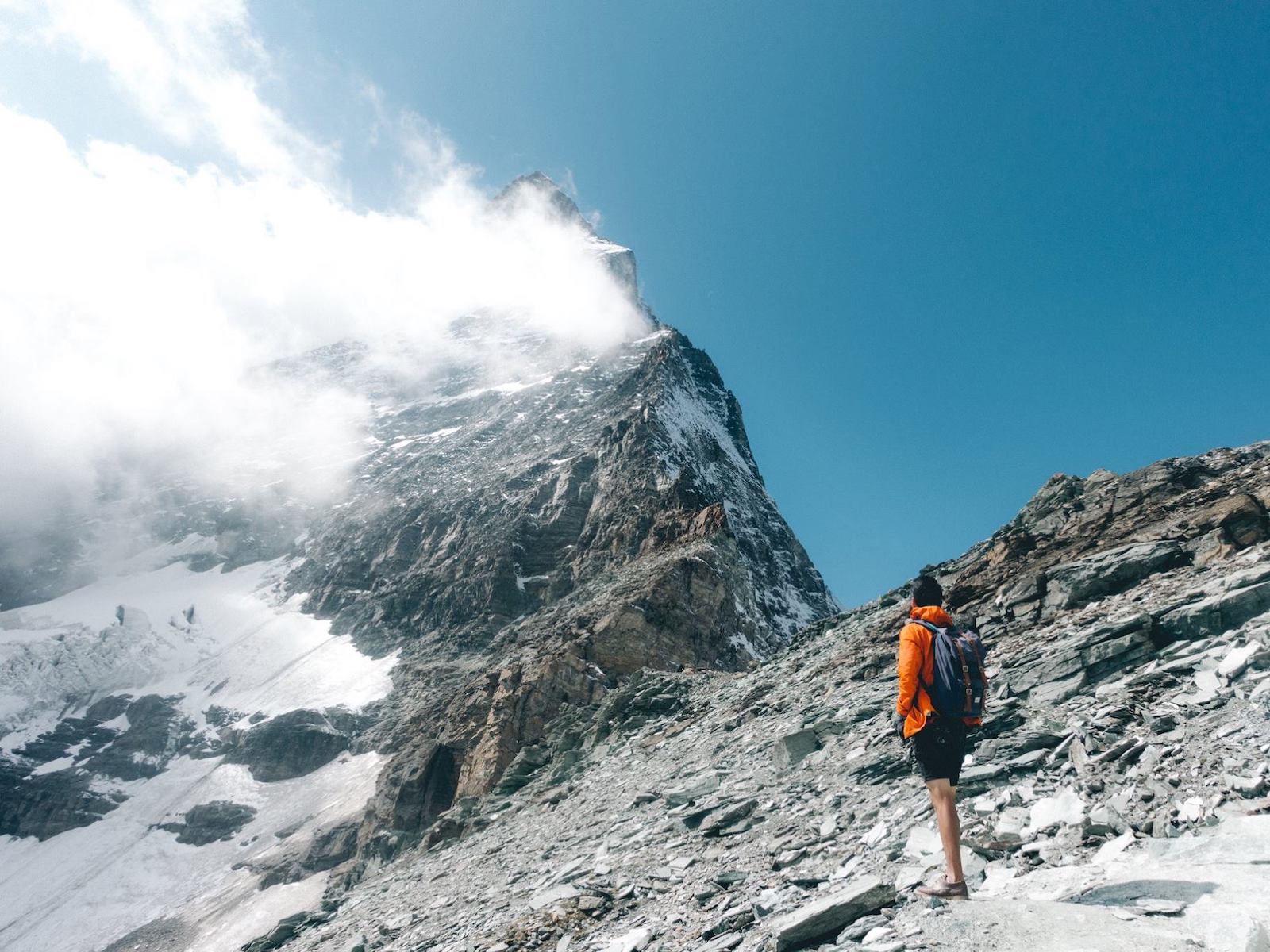
8) The Schwarzsee and Hornlihutte Trails (Switzerland)
Location: Zermatt, Switzerland
Length: 8 – 10 hrs return
Highest Altitude: 1,695 feet
Distance: ~15 miles
Difficulty: Moderate but Long
This is a combination of two trails that will get you the closest to the famous Matterhorn peak in Zermatt, Switzerland. The first part of the trail starts from the city of Zermatt and as you follow your way up the gondola line, you will arrive at Schwarzsee Lake where you can rest, have coffee at the mountain hut and continue your way up to the Hornlihutte. This is the exact location where one of the first climbers set off for their first ascent on the famous mountain in 1865.
You will go through a small traditional village before climbing up through the forest out into the exposed area at the Schwarzsee Lake. The landscape will become more rugged and rocky as you make your way up to the Hornlihutte mountain hut. If you decided to take an alternate route back via the Glacier trail, you will also be able to admire the mountain from the bottom of the glacier looking up. That was quite a sight to behold.
At the end of the Glacier trail, you will arrive at the Trockener Steg Lake where you can see the Matterhorn’s east face reflected off a body of water. There is no better way to see the Matterhorn than to hike this trail.

9) Laguna de los Tres trail (Argentina)
Location: El Chalten, Argentina
Length: 7 – 11 hrs return or 2 days
Highest Altitude: 3,871 feet
Distance: ~7.7 miles
Difficulty: Easy
Of course,Patagonia has to be on the list, but maybe this might not be the trail you are expecting. There are plenty of hiking opportunities in Chilean and Argentinian Patagonia, but the one I like the most is the Laguna de los Tres trail on the Argentinian side, starting from the quiet town of El Chalten.
This trail is my favorite because unlike the Torres del Paine and W Trek in Chile, the experience of hiking the trail is not ruined by the massive crowds that come with the peak season and has been plaguing those trails. Laguna de los Tres trail is a little less crowded, but offers you a similar experience as the trail will take you up close to the 3 famous landmarks of Patagonia, Mount Fitz Roy, Aguja Poincenot and Cerro Torre.
The trail is relatively easy compared to the other ones listed here with the majority of the trail pretty flat with two steep climbs at the beginning and at the end. You will pass through beautiful native woodland along the side of a mountain, coming across vast glaciers, frozen lakes and a few granite spires. As you continue on, you will pass through two camps where the last camp, Campamento Poincenot, is where you can stay overnight should you decide to extend the trip to two days. If you do so, I would recommend you go up to the Laguna de Los Tres as early as you can for the sunrise.
At the end of the trail, you will be rewarded with a stunning view of the impressive cobalt blue lake and icebergs of Laguna de Los Tres in the background. Over the icebergs, look up and stare at the looming spires of Fitzroy and its neighbors in awe and realize how fortunate you are to be able to see such beauty with your own eyes.

10) Laguna 69 (Peru)
Location: Huaraz, Peru
Length: 6 hrs return
Highest Altitude: 15,000 feet
Distance: ~7.4 miles
Difficulty: Moderate
Last but not the least, we are back in Huaraz again for another of my favorite trail, the Laguna 69 trail. This time, it only requires a day to complete but you will be rewarded with such a diverse scenery and plenty of photogenic mountains that you might forget you are doing a day hike. The trail begins slowly climbing through the valleys with several steep climbs along the way. Halfway through the trail, you will find a great spot by an alpine lake for a lunch stop before continuing on through a vast grassland. Push through the small granite path and head in to the heart of the mountain, where you will find a pristine blue glacier lake tucked away in between snowy mountains.
The moment you start to approach the lake, you will see a bright blue color, like nothing you have ever seen in nature. That’s when you will realize that you have finally reach Laguna 69. There is no mistaking it, the technicolor from the melted glacier is out of this world.
***
Nature has a way of rewarding you if you try hard enough and that is what I feel about hiking. The harder you work for it, the more rewarding it is. The mountain tests you, makes you lose your ego and you humbly appreciate both your own physical condition and the wild beauty of the world. I encourage you to go out there, get your hands dirty and start climbing.

/
 Pete Rojwongsuriya is the founder of BucketListly.Blog, a place where he writes about his travel adventure and life stories he learned for the last 6 years on the road. He is also a travel filmmaker, photographer and a digital nomad, traveling from one country to another, making inspiring travel videos, taking stunning photos and telling a travel story of the world. His work in travel films has been featured on National Geographic, BBC, and Vimeo.
Pete Rojwongsuriya is the founder of BucketListly.Blog, a place where he writes about his travel adventure and life stories he learned for the last 6 years on the road. He is also a travel filmmaker, photographer and a digital nomad, traveling from one country to another, making inspiring travel videos, taking stunning photos and telling a travel story of the world. His work in travel films has been featured on National Geographic, BBC, and Vimeo.
The post 10 Hiking Trails Around the World That Will Blow Your Mind appeared first on The Expeditioner Travel Site.
]]>The post Here Are Five Ways To Do Patagonia’s Torres Del Paine On The Cheap appeared first on The Expeditioner Travel Site.
]]>
Going on a multi-day trek through Patagonia is on a lot of people’s bucket list. Who doesn’t want to visit the Straights of Magellan, Patagonia and some of the most photogenic landscapes in the world? But if you look online the expense seems, shall we say, unfortunate. Okay, not unfortunate, nosebleed expensive.
Saying that you can visit Torres del Paine National Park on the cheap is a lie. You just can’t. It’s incredibly far away, Chile is an expensive country and Chilean Patagonia is even more so. If you look online, flights and tours alone can easily run in excess of $5,000 per person.
While a trip to Torres del Paine will likely never be categorized as cheap, there are a couple of easy things you can do to cut the cost of a trip almost in half.

1) Fly on Miles
A round-trip flight from New York to Punta Arenas will run you over $1,500 — which is about the same as five full-priced Virgin America round-trip tickets from New York to San Francisco. Or, at current Star Alliance prices, you can fly round-trip to Santiago for 60,000 miles with a $10 co-pay. Flights from Santiago to Punta Arenas run regularly and can be purchased from Sky Airlines or LAN and usually cost just a couple hundred bucks.
Don’t have a ton of miles lying around? There are a few clever ways for normal people to accrue tons of miles without being a corporate flier or super wealthy. I’m dead broke and haven’t paid for a flight in years, mostly because I follow The Points Guy like a disciple.

2) Don’t Take a Tour
If you Google “Torres del Paine tour,” you’ll get a seemingly endless number of tour operators eager to send you on an amazing, one-of-a-kind, trekking adventure. You’ll get to “sail up to the face of a towering valley glacier” and “hike above the ice of Grey Glacier” while listening to “the sound of ice calving off hanging mountain glaciers.” Sounds pretty intense — except that it’s all a huge rip-off.
Literally everything they’re offering on most of these tours is available to the general public at much lower prices when you arrive in Chile. The transportation, the accommodation, the food: it’s all the exact same thing you’d be doing if you just showed up and did it yourself.
It’s kind of like if you started a website in Mandarin Chinese that offered an “Amazing Manhattan Adventure,” Then for $2,000 you offered to take some poor sap on the Staten Island Ferry and up to the top of the Empire State Building. But that’s not all, you’ll also make sure to take care of their lunch at Ray’s Pizza and book them a room a Hostelling International — tidy profit margin.
When I was looking to go to Torres del Paine I found this well SEOed 4-day tour of the park marked for $1,950 a person. The price doesn’t include a flight and assumes you can get yourself to Puerto Natales, even though the closest airport to Puerto Natales is fours hours south. Check out what they’re offering:
“Day 1: Puerto Natales. Grey Boat. Hike Grey-Pehoe. Camp Pehoe.” That means you’ll take a $20 bus, get on a $30 ferry, walk on well-marked trails and camp in rented gear at a campsite that charges about $7.50 a night.
“Day 2: Hike Pehoe to Cuernos. Camp Cuernos.” You basically walk from one campsite to another and stay in another campsite that costs about $7.50 a night. The horrible thing is that this itinerary actually has you walking past a free campsite that’s way nicer. It also has you walking right past the French Valley, which is one the most impressive parts of the entire park.
“Day 3: Hike Cuernos to Chileno. Night refugio Chileno.” Like the day before, you’ll walk from one campsite to another, and then stay in a hostel that costs $40 a night.
“Day 4: Hike to base of Towers. Transfer to Puerto Natales.” You walk up a hill, look at the Torres Towers and then take a $20 bus back to Puerto Natales. Presumably you’re on your own to get back to the airport in Punta Arenas.
Total Value: $121.50. To be fair, the tour also includes food (about $130 a day if purchased in the park), park entrance ($40), rented camping gear ($200), an English-speaking guide and porters to take care of your bags.
That means you could do the same thing for $881.50 and still have $1,068 left over to hire some guy to show you around incredibly well-marked trails. Or you could use it to buy a flight.

3) Camp
There are a series of hostels, or refugios in Torres del Paine parlance, set up around the park. They’re big, modern and warm, and have all the amenities of a hostel in a city. They also have considerable downsides. They’re expensive, they book up months in advance, and they are packed full of the sort of people who took that $2,000 tour.
The park has several absolutely free and very well maintained campgrounds. There are other campgrounds that charge a couple of dollars and offer all sorts of amenities. I’m talking about hot water showers, clean flushing toilets, electrical outlets and access to small stores.

4) Bring Your Own Food/Booze
You can, and many people do, purchase all your food while you’re inside the park. For about $130 a day the refugios offer a full day’s food, and from what I could tell, it looked pretty good. But for much cheaper, there’s a large, modern grocery store outside the park in Puerta Natales. They have a good selection of camping-appropriate foods and a decent booze selection.
Speaking of booze, there are bars at the refugios inside the park, but prices are extortionary — they know you’ll be thirsty for a strong drink after a long hike. Think ahead and grab a bottle of something stiff in Puerta Natales. I highly recommend packing in a bottle of whiskey for its high alcohol-to-weight ratio. Not only will you be the most relaxed person at the campsite, you’ll also be the most popular.
5) Rent Your Gear
Because Torres del Paine is such a remote destination, it attracts a lot of campers with deep pockets. These campers then go hog-wild at their local gear store buying some beautiful equipment that’s complete overkill.
I watched one French octogenarian spend about an hour trying to figure out how to set up a brand new $700 tent that I’m guessing will spend the rest of its life in an attic. Once he figure out how to get the tent up, he then spent the next half hour putting together $600 worth of super lightweight trekking cots for him and his wife. While I’ll admit a certain amount of gear jealousy, it seemed like a bit absurd.
If you go trekking all the time and have gear, awesome. But for the rest of us, there’s no need to drop several thousand dollars at Eastern Mountain Sports before leaving home.
Just outside the park in Puerta Natales there are tons of places that will rent you everything you’ll need for about $50 a day. The gear they’re offering is chosen specifically for the needs of hiking in Torres del Paine: light, wind-resistant and warm.
*
The fact of the matter is that taking on Torres del Paine will never be cheap. That said, it can be done far cheaper than you’d expect. And, regardless whether you pay $800 or $8,000 for the trip, your pictures will be just as beautiful. Take that extra cash and tack on some time enjoying Santiago or the incredible street art of Valparaiso before heading back to the States.

/
 You’ll likely find Anthony traveling, hiking, cooking or horribly mangling photos in Photoshop. When that doesn’t work, he drinks whiskey. Anthony used to cover city news, business and politics for DCinno in Washington D.C., but left to explore South America. Now you’ll find him drinking whiskey on the beach.
You’ll likely find Anthony traveling, hiking, cooking or horribly mangling photos in Photoshop. When that doesn’t work, he drinks whiskey. Anthony used to cover city news, business and politics for DCinno in Washington D.C., but left to explore South America. Now you’ll find him drinking whiskey on the beach.
The post Here Are Five Ways To Do Patagonia’s Torres Del Paine On The Cheap appeared first on The Expeditioner Travel Site.
]]>The post Why Touring Buenos Aires By Camera Is The Best Way To See The City appeared first on The Expeditioner Travel Site.
]]>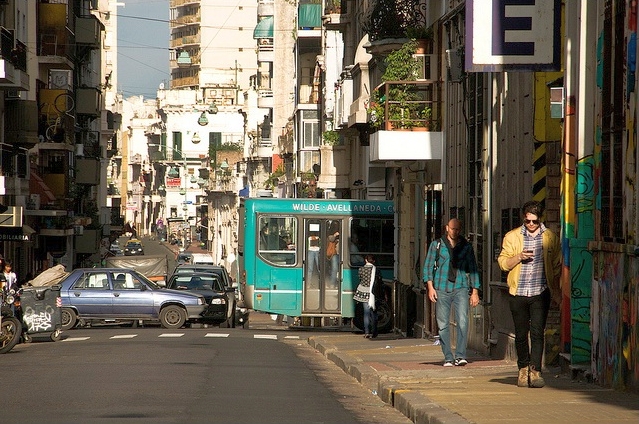
With its grandiose architecture, beautiful people and downright gritty street scenes where all these elements come together, Buenos Aires is a city made for photography, and according to the founders of Foto-Ruta, there is no better way to tour Buenos Aires, Argentina’s capital, than to do it through the lens of a camera.
In what is best described as a half-tour, half-photography workshop with an extra jolt of creativity, Foto-Ruta takes participants through Buenos Aires’s most visually appealing neighborhoods and pushes them to test the limits of not only their cameras, but the way they see the city.
“We started Foto-Ruta because Buenos Aires doesn’t have a checklist of places to visit like, say, Paris or New York,” said Jocelyn Mandryk, a Canadian photographer and Foto-Ruta co-founder. “The magic of this city is more about getting lost, wandering around and eventually stumbling into a beautiful cobblestone street and taking it all in. We are here to encourage people to explore and to teach them how to convert these experiences into amazing photos.”
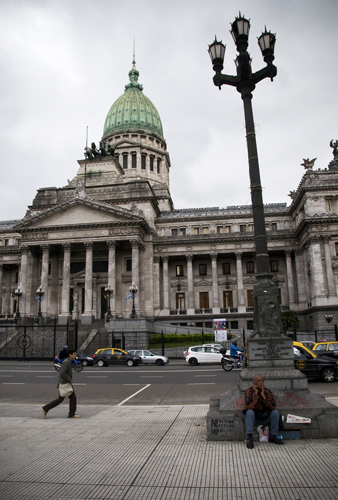
Each Saturday, Foto-Ruta meets in a different neighborhood and gives participants an hour-long photography class in a local restaurant or cafe. Then, camera in hand, participants are split up into teams and given a list of clues (similar to a scavenger hunt) and are sent out into the streets to take photos that correspond with the clues.
There are no guides, few rules, and while it may sound simple, clues like “A good place for vampires” can have you running around all afternoon looking for the creepiest, darkest abandoned mansion in the city. The day I took the tour, my German companion and I scratched are heads as we looked over our list, trying to find items that fit with the clues: “Yesterday’s beauty”, “Better eaten the next day”, “Negative space” and “Underground muse.” It was challenging, but we passed a good time.
“This is a creative experience and we don’t want to be looking over your shoulder, telling you what to do and which aperture to use,” Mandryk said.
Aside from the list of clues, the only task participants were specifically told to do was take a portrait of at least one person. “The people of Buenos Aires are one of the main reasons we started this project,” Mandryk said. “The people here are not shy. They are beautiful, proud and very approachable. Nine times out of ten you can ask for a portrait in the street and the people will let you do it. Who knows? If you try it you might walk away from an encounter knowing someone’s life story.”
After a few hours of scavenger photo-hunting, participants meet up again at the starting point, upload their images to a computer and review the results as a group. This can make for a very hilarious and very helpful experience. I say hilarious because you get to see how different teams interpreted the clues, and I say helpful because Mandryk, a professional photographer, looks over your photos and critiques your work in a very constructive manner.

My submission for the “Negative Space” clue
Regardless of your experience with photography or the size of your camera, Foto-Ruta can help anyone become a better photographer. If you’re a beginner, Foto-Ruta will open your eyes to the endless photo opportunities in urban environments. If you’re a well-seasoned amateur, the tour will force you to think about photography in ways that you may have forgotten since you got comfortable with your camera.
The innovative Foto-Ruta concept was hatched about one year ago by Mandryk and Becky Hayes, a British marketing director. While their most popular offering is the weekly Foto-Ruta neighborhood tour (which costs USD$29), they also offer a variety of photography-related workshops and lessons.
As of last month, Foto-Ruta has also begun operating in New York City with the hopes of expanding to more cities around the world. With good reason too. What better way to explore a new city other than to make a game out of it and learn useful photography techniques in the process?
By Diego Cupolo

About the Author
 Diego Cupolo is a freelance photojournalist currently on the road to Tierra del Fuego. Most recently he served as Associate Editor for BushwickBK.com, an online newspaper in Brooklyn, and his work has appeared in The New Yorker, The Atlantic, The Star-Ledger, The Australian Times, Discover Magazine and many other publications. View more of his work at DiegoCupolo.com.
Diego Cupolo is a freelance photojournalist currently on the road to Tierra del Fuego. Most recently he served as Associate Editor for BushwickBK.com, an online newspaper in Brooklyn, and his work has appeared in The New Yorker, The Atlantic, The Star-Ledger, The Australian Times, Discover Magazine and many other publications. View more of his work at DiegoCupolo.com.
The post Why Touring Buenos Aires By Camera Is The Best Way To See The City appeared first on The Expeditioner Travel Site.
]]>The post Lost And Found In Buenos Aires appeared first on The Expeditioner Travel Site.
]]>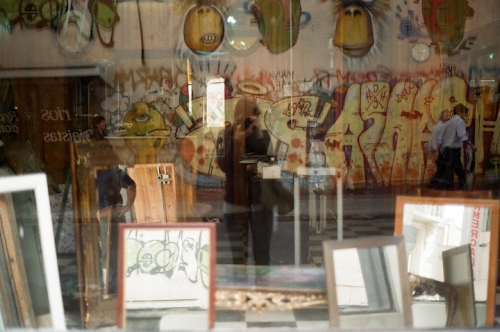
Sometimes we travel for our soul’s journey, to discover something about a place and something about ourselves. Time and again, people believe that those that travel are “running away from something,” and I keep saying, “perhaps we are running towards it.”
Round one, Buenos Aires: a surreal, old-world cultural experience. A time to learn tango and how to properly share mate. Stepping off the plane into a humid heat with cab drivers vying for fares somehow made me think of Cambodia. I remembered that tense feeling of culture shock and really experiencing what “the hustle” meant.
Arriving downtown and walking the streets, the men would wolf-whistle and cat-call. It was another shock and often times offensive. My immediate reaction was to take alternate walking routes around our San Telmo neighborhood, unsure of what small hollers could lead to. I was, after all, in the “Latin America” that is often portrayed in our media as rife with illicit sex, drugs and violence. I even found going to the corner cafe nearly impossible to stomach, unsure of whether I should hold keys between my fingers and get my big person voice on. This was my first time in another country to live and I was living in a state of anxiety. In the moment I thought, wow, I have to do this for six months. I ached for my comforts of home.
After the six months, I returned to real life in North America, but things had changed. Life had to be reset in order. Yet, I was still on the Latin American adrenaline high. The intensity motivated me to get myself a new apartment and a new part-time job. I owned barely any furniture, but had the chance to attend a few beautiful weddings. Looking back, I can remember certain moments, but I was in a dark haze of not feeling a thing. By the end of a summer blitz (early-morning coffees and afternoon beers in parks with bicycles), I remember looking around my room and falling into that vortex of, well, why not? Why not go back to Buenos Aires? I was still on a roll, but could feel the comedown of my ideal lifestyle fading.
*
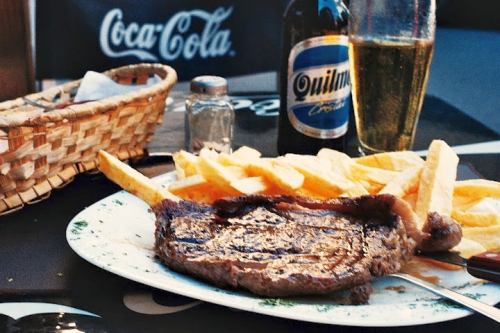 Round two, Buenos Aires was different. It began with a one-bedroom apartment in the neighborhood, Tribunales. It was close to everything: the beautiful architecture of the judicial district, the high-end shopping (albeit, window) of Avenida Santa Fe, in Recoleta, the inexpensive shopping in the Once neighborhood. I had my grocery store (a Coto), my fruits and veggies man down the street, the doorman (Rodrigo) who would say hello to me everyday (Como andas, Bretana?). I remember watching him interact with the people walking the streets with a warm smile. Everyone knew and loved Rodrigo.
Round two, Buenos Aires was different. It began with a one-bedroom apartment in the neighborhood, Tribunales. It was close to everything: the beautiful architecture of the judicial district, the high-end shopping (albeit, window) of Avenida Santa Fe, in Recoleta, the inexpensive shopping in the Once neighborhood. I had my grocery store (a Coto), my fruits and veggies man down the street, the doorman (Rodrigo) who would say hello to me everyday (Como andas, Bretana?). I remember watching him interact with the people walking the streets with a warm smile. Everyone knew and loved Rodrigo.
Inside the apartment there were some issues (a leaky faucet, a running toilet, a sky light that poured gallons of water into the kitchen on a typical stormy summer night). Trying to get anything fixed became a three-part challenge (address Rodrigo about the problem, he would tell me solutions, and I would have to hassle the plumber or Internet service people day after day). There was a language barrier as some of the people would not translate Spanish, preferring to talk in their dialect, castellano. So, by night, I would venture into the city bars to brush up.
Nights out alone, just wanting to talk and the people wanted to talk.
“Where you from? How old are you?”
“Does it matter? I just want to talk.”
I felt the tension creeping back in. I just wanted to talk about how to fix leaky faucets.
As two months leapt by, my castellano was improving. I felt more confident to find a job. I applied to hostels and bars. However, the reality that I could only work for another two and a half months was not what a business was looking for. I was getting desperate, and all I could do was lay down about it: Life as a pendulum, as a wave, as a spiralling circle. Revolutionary. It was a slap of reality in my foreign fantasy.
I needed to clear my head and I needed to do it on a budget. So, I walked and decided to take my camera with me to capture the beauty that is the essence of why people go to Buenos Aires. Even with all the beautiful architecture, the unique people to capture, I could not release the fear that I had no idea how I was going to survive the next couple of months.
I have a friend who lives in Buenos Aires, and her niece (who became a very good friend of mine) was visiting. At night, we would take visitors to bars in the San Telmo area. Some nights, I would stay at my friend’s place and wake up to beautiful music with a killer hangover. One morning, while having cookies and coffee for breakfast, my cellphone rang and it was for a job interview at a hostel, Kilca.
I was able to work for two and a half months in exchange for a bed. Suddenly, I felt lighter. One less thing to worry about. As I walked back to the apartment to pack my things, I decided to sit on a bench in a park. It was all happening so fast and I was feeling a bit dizzy. It made me nervous to try a new job and to meet new people I knew I would have to leave in the not-so-far future. I did not know how I was going to cope with the process. For the first time since re-arriving, I felt the intense fear creeping back in. I wondered whether I should just pack up my things and go home, instead.
Back at the apartment, I Skyped my family to express my concern. They told me it would be ludicrous to travel as it was cold and snowing back home. Just enjoy yourself, they told me.
What if, what if, what if . . . what if I couldn`t do it?
The body does not know good stress from bad.
I packed up my transient life into my one suitcase that I brought with me: a few pieces of clothing, a couple of books, some toiletries that I had picked up from my local Coto. I asked Rodrigo to hail me a cab which took me down the street to the hostel, my new home. Despite my calm exterior, my nerves were still a little shaken: I was broke and in an existential crisis, bare necessities in tow.
*
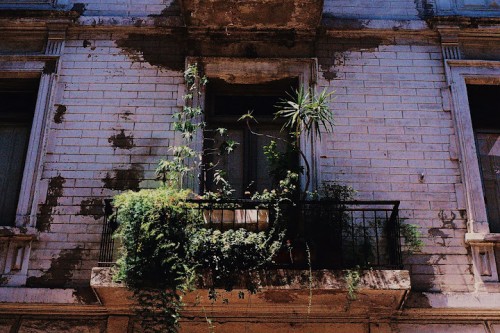 The “what if” of worse possible things that could happen never happened and swiftly, a calm had settled over me. Through the incongruousness of routine (waking and sleeping at varying hours), the experience of getting to know the locals, sipping coffee while others sipped mate, learning new mulit-meal cooking techniques in order to ensure dinner over the span of a week, I discovered a patience for time.
The “what if” of worse possible things that could happen never happened and swiftly, a calm had settled over me. Through the incongruousness of routine (waking and sleeping at varying hours), the experience of getting to know the locals, sipping coffee while others sipped mate, learning new mulit-meal cooking techniques in order to ensure dinner over the span of a week, I discovered a patience for time.
My last two and a half months living at Kilca, the backpackers hostel, were undefinable. I had the opportunity to meet some of the most interesting and adventurous travelers, and to forget about my worries and my strife. I often reminisce of the times I spent late hours of the night into the early hours of the morning listening to people’s thoughts and stories about travel.
Because of the large interior patio, we received many motorcyclists touring the world. We also accommodated people who had decided to start mountain climbing, families that were taking a six-month excursion to show their children different cultures of the world, and dancers who wanted to find the spark of tango. All sojourners who were not lost, but looking for their treasure buried within.
Our home became the harbor to sailors venturing the vast sea. I feel fortunate that for a couple of months, we lived on the ship that never sailed.
This was the life I had chosen, to wander and wonder and learn that, at times, I may be lost, but even in the darkest hours of night, you can find a lightness.
By Brit Weaver

About the Author

Toronto born and based, Brit is an avid leisurely cyclist, coffee drinker and under-a-tree park-ist. She often finds herself meandering foreign cities looking for street eats to nibble, trees to climb, a patch of grass to sit on, or a small bookstore to sift through. You can find her musing life on her personal blog TheBubblesAreDead.wordpress.com.
The post Lost And Found In Buenos Aires appeared first on The Expeditioner Travel Site.
]]>The post Buenos Aires Was Really Romantic In 1932 (And Kind Of Sexist Too) [Video] appeared first on The Expeditioner Travel Site.
]]>This movie short by MGM from 1932 shows Buenos Aires during its glory years. Well, glorious for the rich men who lived there, a little less so for the natives, the cows and the women who also inhabited “The Argentine” at the time.
Check out the great shots of Plaza deMayo at 2:49, and BA’s famous Calle Florida at 3:02, which back then allowed not only cars (today it’s pedestrian-only) but also horses (expect to see leather goods and street performers today).
Apparently, in the early part of the century, you could also expect fresh milk while you strolled around the city, and by “fresh” I mean milked from a cow standing on the sidewalk.
As was noted while visiting the Palermo race track, it was against the law for men to appear in public without a coat, which meant many men (apparently when they were betting on the fillies) would don pajama coats as a way to skirt the law (you could be fined 5 pesos otherwise).
It should also be noted that as the narrator points out, modern times hadn’t yet corrupted the romance of “Old Spain” in Buenos Aires at the time. In fact, the romance still existed as evidenced by the women of the Argentine, who were apparently seldom “troubled about the rights of their sex or any of the more virile notions that [had] stirred modern womenhood.” Not to worry, they were apparently content with “the admiration so lavishly bestowed upon them” by the men around them. Sheesh, sounds like the life of a city cow wouldn’t have been a bad alternative.
[Romantic Argentina 1932/YouTube]
The post Buenos Aires Was Really Romantic In 1932 (And Kind Of Sexist Too) [Video] appeared first on The Expeditioner Travel Site.
]]>The post Ideas For Travel To South America This Fall appeared first on The Expeditioner Travel Site.
]]>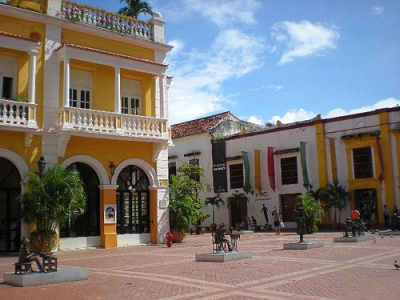
Is there nothing better than shipping off on a red-eye flight in the depth of a cold winter night and arrive, half-a-day later far on the other side of the Equator (assuming you’re coming from the north) in warm South America? Plants are budding, locals are excited about the onset of summer, and you’re just glad to spend a week or two far from any vestiges of black snow banks and flu-infested workplaces.
With that in mind, Condé Naste Traveller (or what I like to sometimes call Condé Nasty if they let me) decided to ask South American travel expert Sue Lyall about where to go, what’s hot, and where to stay in the continent. Here are the highlights.
Hottest Country: Argentina, for its hiking, good eats, llamas and wide variety of activities in this large swath of land. You had me at llama.
City to Visit: Cartagena, because of its historic old city, its nightlife and its beaches. And also because people, despite everything that’s been written about the country, don’t realize how amazing Colombia is, so it’s not totally overrun by tourists yet. It will also make you realize how completely unaesthetic your neighborhood is back home.
Best Place to Stay: Pousada do Toque hotel in Alagoas in Brazil, because it’s located on the ocean just north of Bahia, there are manatees there (enough said!) and the area is still pretty unknown, thus once again, not too many tourists.
The post Ideas For Travel To South America This Fall appeared first on The Expeditioner Travel Site.
]]>The post My 10 Ways To Revamp Argentina’s Top 10 Foods appeared first on The Expeditioner Travel Site.
]]>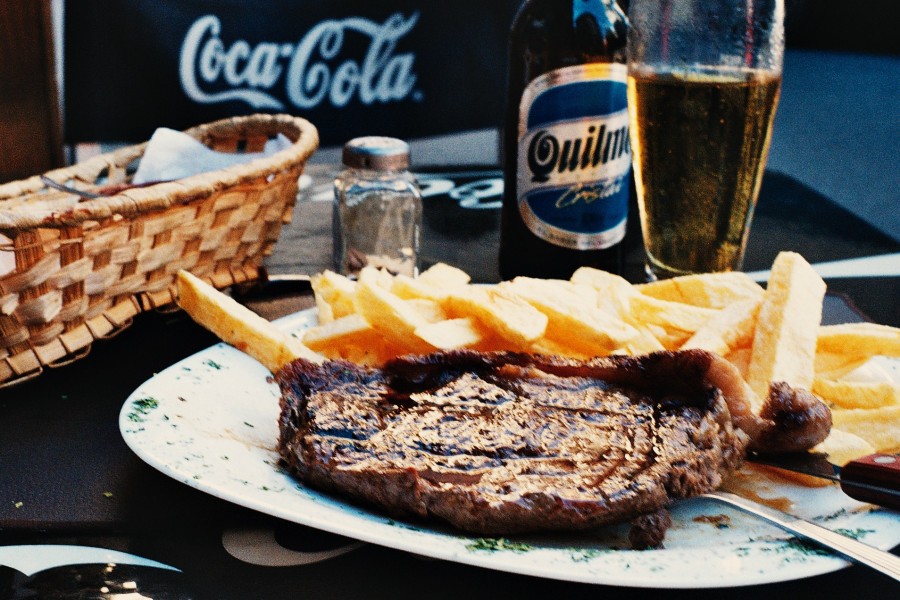
Every food needs a little evolutionary jump-start once in a while. As a fan of mash-ups (some of my favorite foods include shepherd’s pie and bubble & squeak — a post-Thanksgiving swirling concoction of leftovers), I think that combining one’s culinary cultural upbringing with that of another can only bring about good things.
Which made me wonder when reading this article on GoMadNomad.com about the top ten foods in Buenos Aires: What if I put a little spin on the list and came up with my own mash-ups?
So, here it is, my Argentinean mash-up on their top ten dishes.
1) Asado: Typical Argentine steak. Salted. That’s it and it’s delicious. But, how about adding on some homemade BBQ sauce?
2) Chorizo: Typical in a Choripan, throw in some potato chips, find some jalapenos, or melt down some of their infamously Queso de Campo for some homemade cheese sauce.
3) Empanada: We love them, but have them often enough and you start to crave some variety, like mushrooms and jalapenos.
4) Matambre: Nothing much you can do with a matambre unless you would like to make one yourself.
5) Milanesa: Sub in fish, anyone?
6) Pizza: Very doughy and not a whole lot of options for topping. One day, we made our own pizzas while living in B.A., throwing on basil, fresh tomatoes, chilis on mine, and various varieties of of cheeses.
7) Dulce de Leche: Typical for pastries and tostadas, but it’s especially delicious in rice pudding with cinnamon — so rich and tasty. Or, try it as a topping to a banana split.
8) Alfajor: These cookie-like snacks come in many varieties and in all kinds of brands. But when dipped in coffee, they’re a wonderful post-asado dessert or breakfast of champions.
9) Medialuna: A friend of mine in Buenos Aires had luckily brought a reserve of nutella (and hazelnuts are becoming more and more popular there). She served us the medialuna with dollops of hazelnutty goodness. You can buy cooking peanut butter, and if you sprinkle some salt on it, tastes just like the real thing.
10) Submarino: The classic Argentine hot chocolate (hot milk with chocolate served on the side that you add in) is perfect for cold days. What was I thinking by never trying one? But I fully intend to make one at home with cold milk and dulce de leche ice cream: an Argentine milkshake. Wouldn’t that be divine? And, at the end of the experimental journey, a steak with fries and a litre of Quilmes would be like a cherry on top.
Buen provecha!
By Brit Weaver

About the Author

Toronto born and based, Brit is an avid leisurely cyclist, coffee drinker and under-a-tree park-ist. She often finds herself meandering foreign cities looking for street eats to nibble, trees to climb, a patch of grass to sit on, or a small bookstore to sift through. You can find her musing life on her personal blog TheBubblesAreDead.wordpress.com.
The post My 10 Ways To Revamp Argentina’s Top 10 Foods appeared first on The Expeditioner Travel Site.
]]>The post Buenos Aires: Living In A City Of Passion (And The Comedown) appeared first on The Expeditioner Travel Site.
]]>
I remember when I first walked the streets of San Telmo — a neighborhood in Buenos Aires — and becoming hyper aware that I was no longer in North America. The people, the architecture, the steak, the all-night partying was all very grandiose. The young ladies talking loudly on their phones, the groups of guys making theatrical jokes on the buses, the people in line at the bar gesticulating wildly. For the first couple of months, I felt very small.
I read this recent article in The Telegraph about an author’s experience in the city rumored to be of passion, pessimism and drama. When it came down to life and relationships, one porteño described how in Buenos Aires, “We don’t have a middle road . . . We love or we hate.”
It’s black and white, yes or no, straightforward and to the point. It’s bold and it knows what it wants. It appears to have confidence. And I wonder why and think that perhaps it is something in the air. As the author describes, “[T]he real magic of the city lies in something essentially Latin. Trying to discover just what that something is can be the most fascinating part of a visit.”

Trying to live through it was almost a sensory overload. The energy of a city so intense leaves you permanently elevated. In the beginning, it was funny and flattering. Some days I would get dizzy with the frustration of trying to hold a conversation with some porteños for longer than an hour. Towards the end of my stay in the city, it just was what it was. Like the article implied, if sitting at a bar, the men do “throw themselves at you,” but if you are uninterested they leave just as quickly.
Eventually, living in this kind of atmosphere did prickle me a little. And like all good cities, when you live with it, you take the bad with the good (alas, no city is perfect). Sometimes, the imperfections (like lack of interest in clean streets and a functional recycling program), are the tiny details that can be worked on. What matters is if it has a good heart.
Now, since moving back to North America, rifling through pictures of my home to the south, it’s those small imperfections that I miss. And the comedown gets harder every time.
By Brit Weaver

About the Author

Toronto born and based, Brit is an avid leisure cyclist, coffee drinker and under-a-tree park-ist. She often finds herself meandering foreign cities looking for street eats to nibble, trees to climb, a patch of grass to sit on, or a small bookstore to sift through. You can find her musing life on her personal blog, TheBubblesAreDead.wordpress.com.
The post Buenos Aires: Living In A City Of Passion (And The Comedown) appeared first on The Expeditioner Travel Site.
]]>The post Wandering Around Montserrat appeared first on The Expeditioner Travel Site.
]]>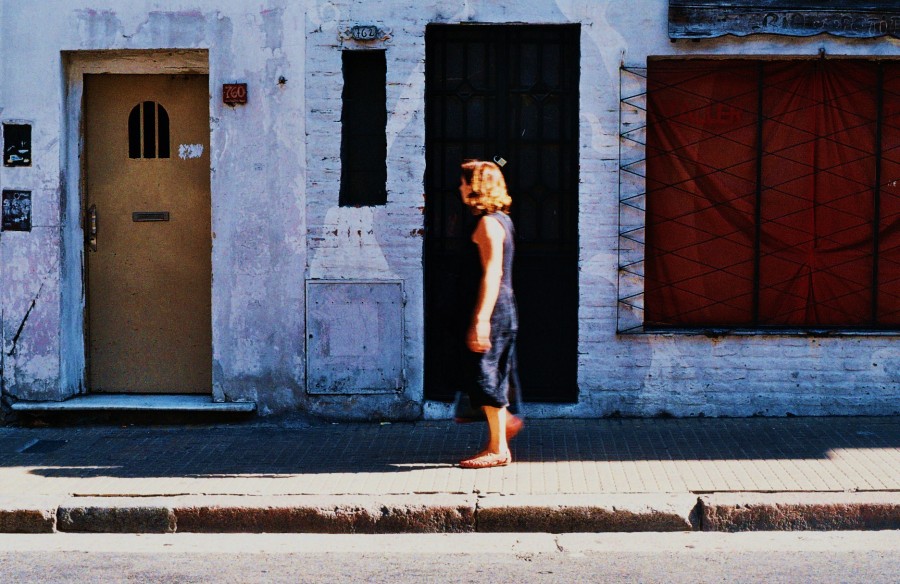
I have a knack for wandering around cities, losing my way for a few hours, but always finding my way to where I am headed. I think most travelers have this innate characteristic, but somehow I always forget to bring a map with me. It’s not intentional, I am just slightly spaced out. With so much to remember — keys, passport, cell phone, cash, books, papers, pens, etc. — it would be robotic to not forget something when running out the door.
So it was, a few months ago, I left my apartment in Buenos Aires and walked towards “the general direction” of San Telmo, the neighborhood (barrio) notorious for old buildings and bohemian artisans. I walked along the street, Montevideo, passed the Congreso barrio — where gorgeous ancient colonial architecture marks the political city of the past (as the Centro barrio is the polito-economic center of the present) — and entered a not-so-pristine part of town. The buildings are a little crumblier, a couple more dog bombs than usual and lots of crooked trees.
Many travelers also get a little homesick and remedy the queasiness using various methods. My prescription is to find neighborhoods within cities that remind me of home. My informative years were spent on a farm and romping around a small town. While living in Toronto, my home was in the neighborhood called Little Portugal. There, small family-run general stores and run-down bars filled with avid soccer watchers made me feel at ease. It was my Seltzer.
I remember visiting Mr. Matt Stabile in the summer and staying at the New York Loft Hostel, just on the cusp of Williamsburg and Bushwick. It had the same ambiance of “community,” which allowed me to not focus on the fact that the hostel’s shower did not have hot water. (Totally over it now. I was just being a princess.)
So it was, when I walked into this Buenos Aires’ neighborhood called Montserrat, it was like a breath of home air. Good air. Buen aire. (Minus the dog bomb smell.) It finally felt like I had found my home-away-from-home.
I believe that most people who live abroad start feeling homesick because of a sensory overload: new sights, new sounds, new smells, new languages. We can get dizzy with despair. We begin to crave the comforts of home — whether it is peanut butter, wool socks (in the middle of summer), our favorite programs that we live-stream from the internet, downloading music and/or face-creeping friends — just to get a fix.
Sometimes, we become a little lost in our discomforts and we forget to discover something even newer. The last time I was in Buenos Aires, I embraced the “old” Argentine ways (tango, traditional maté, horseback riding) and did not see how this city, just like most cities, is evolving. Nowadays, the kids are sipping maté (South American tea) with juice or milk and throwing in high kicks for Tango Nuevo. Last year, I was getting sick of accordians so I put on my headphones and listened my nostalgic North American big bands (ignoring the new Argentine rock — like Divididos or Cerati).
I forgot to keep trying new things.
Still, once in a while, when you feel like you are losing yourself in a culture or custom, you just need to find a little vintage store or coffee shop to remind you that you can find your comforts anywhere. You relax, choke up a little, and then head out again to try something new.
And sometimes, it just takes a little wondering, a little time and a little wandering to find some comfort in your home-away-from-home.
By Brit Weaver

About the Author

Toronto born and based, Brit is an avid leisure cyclist, coffee drinker and under-a-tree park-ist. She often finds herself meandering foreign cities looking for street eats to nibble, trees to climb, a patch of grass to sit on, or a small bookstore to sift through. You can find her musing life on her personal blog, TheBubblesAreDead.wordpress.com.
The post Wandering Around Montserrat appeared first on The Expeditioner Travel Site.
]]>The post Take Two And Tango In Buenos Aires appeared first on The Expeditioner Travel Site.
]]>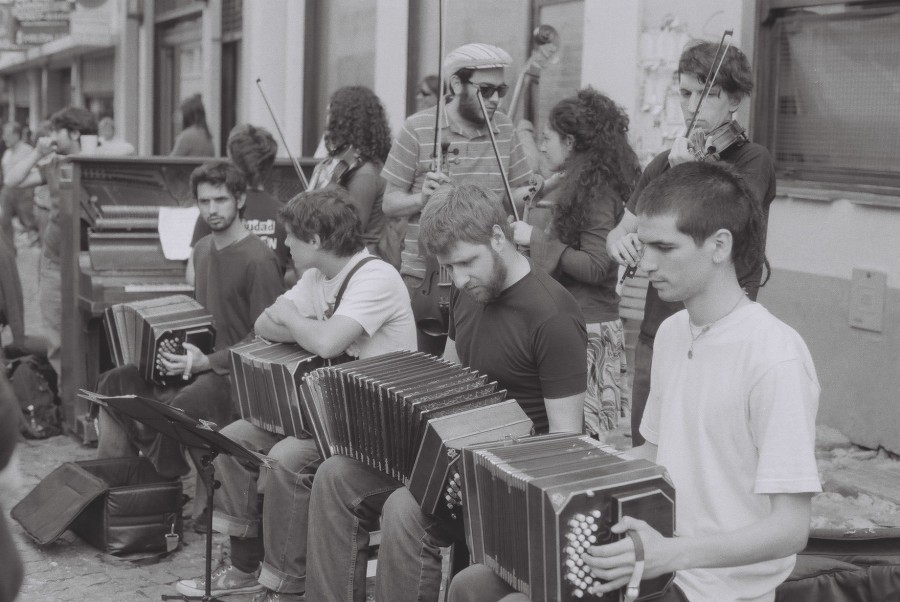
I returned to the Plaza Dorego in the Buenos Aires neighborhood of San Telmo to watch the people dance. Every Sunday Night, one side of the plaza is reserved for a milonga — the Argentine word for a place to tango. It’s a tradition for the class to go. Every Sunday.
To the right, a samba band started — loud drums, hooting, hollering.
“It is completely disrespectful. This is Argentine culture and they are ruining it,” my friend said.
I tried to hide my tapping toes.
Tango (much like mate and football and steak) is a part of Argentine pride (although some Uruguayans will claim the dance as their own. Who knows? Not I.) To put down tango would be like saying “hockey sucks” to a Canadian or “wine is better” to a German. Or would it be?
There can be a lot of negative aspects associated with globalization (marginalization, poverty, infringement of human rights, etc . . .), but the reality is, it is happening and there is some good stuff, too. I know of some amazing people who, when traveling, tried to help out where they could, volunteering, exchanging cultural ideas, bringing over wine for friends, essentially just being conscientious people. Most of us are. One couple I had the pleasure of traveling with even took in a dog off the streets one cold, Argentine-autumn night. I guess you do what you can when you can.
So it was when reading a recent article on tango in the New Zealand Herald, that I started thinking about fusion. What started this spark was when Geoff Cumming, the writer of the article, wrote that “Palermo is where you find your cutting-edge Latin beats.”
I wondered, why?
Perhaps because it’s newer.
As an observation, many of the younger generations are getting back into tango. Perhaps their grandparents or parents are encouraging them to upkeep tradition. What is really fascinating is that these kids nowadays are putting their own spin on it.
The other day when walking through the San Telmo Ferai, I saw a fusion-CD that read “The Beatles/Tango remix”.
Ok. So, The Beatles are not current and neither are CDs, but I thought the idea was incredible.
Back at tango class, they started putting on more “current” tango tunes — accordions mixed with electronica, or Portishead-like ambient music.
I wondered what a tango/samba remix would sound like?
Like all new things, it’s not something we can get used to right away. But, eventually we would and dance the waves.
By Brit Weaver

About the Author

Toronto born and based, Brit is an avid leisure cyclist, coffee drinker and under-a-tree park-ist. She often finds herself meandering foreign cities looking for street eats to nibble, trees to climb, a patch of grass to sit on, or a small bookstore to sift through. You can find her musing life on her personal blog, TheBubblesAreDead.wordpress.com.
The post Take Two And Tango In Buenos Aires appeared first on The Expeditioner Travel Site.
]]>The post 2010 In Review: Co-Editor Brit Weaver’s Picks, Tips, & 2011 Travel Predictions appeared first on The Expeditioner Travel Site.
]]>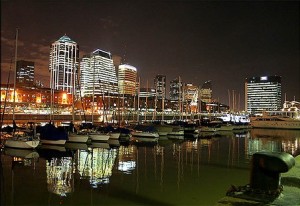
Our second installment of “The Expeditioner’s 2010 In Review” series comes from co-editor Brit Weaver. She’s planning a return trip back to South America, and she’s offering up some thought on the year past and predictions for the year to come:
Your Travel in 2010?
My travel in 2010 consisted of Buenos Aires, Patagonia, Uruguay, and New York City. For the upcoming year, I’m trying to make my way back to B.A. I fell in love with the people, the architecture and the face-sized steaks, and I can’t wait to get back. While there I hope to check out the Mendoza region and Montevideo, capital of Uruguay: the city on the sea.
Travel Tips from Lessons Learned in 2010?
If I were to offer up one tip, I would tell people to travel light. Whether it is luggage, in your walk, the way you talk or in your heart, a steadfast person is not as open to the flow of things. I learned that home is where my heart is and it beats in my chest.
Predictions for Travel in 2011?
Predictions? That’s always a hard one, but here it goes. I think Rio de Janeiro is going to have to wait for the World Cup to arrive to really take off, but I predict that the rest of Latin America (which is far cheaper to travel in) and Italy are going to boom (more so than already).
Travelers are becoming more adventurous with their choices for places to travel in South America as more travelers visit. And there seems to a movement towards romance in the world, and where better could you find that than in Italy, and especially in Venice?Plus, given the popularity of the movie and the book, lots of people are going to want to see the sites from Eat, Pray and Love.
[photo by GustavoBuriola/Flickr]
The post 2010 In Review: Co-Editor Brit Weaver’s Picks, Tips, & 2011 Travel Predictions appeared first on The Expeditioner Travel Site.
]]>The post I Scream, You Scream, We All Scream For Helado! appeared first on The Expeditioner Travel Site.
]]>
You find them lurking everywhere: on the corners of dimly lit streets, in the goopy hands of people, in your freezer. You can hear the icebox-toting vendors screaming its name, beckoning for your business, “Helado! Heladoooo!”
Ice cream. It is a cross-cultural thing.
When venturing into Buenos Aires, some fantasize about steaks and tango, gauchos and gourds of mate. Yet, the unexpected afternoon delight that melts your heart is this dessert.
Growing up as a North American kid, my experience was different. I remember the jingling bells of the bicycle-propelled dickie-dee and the creepy carnival music that played from the white, square truck. Kids would run from their front doors to scoop up a soft serve with their saved pennies. That is my nostalgic ice cream culture.
It was nice to read an article in the NY Times that highlights how Buenos Aires is combining two of their passions: ice cream and dulce de leche, a creamy kind of caramel. I remember trying this frozen post-steak treat for the first time, my mouth shriveling at its sweetness. It’s an acquired taste, one that today’s porteños have had nearly a century to get used to.
The article refers to the flavor as a “national treasure in a cone.” It seems as though much of the Argentine culture surrounds the cow: its meat, its hide, its milk, the lifestyle of the gaucho. Still, they are able to take what is traditional and tweak it by putting together the things that they have. As an attempt to modernize tradition, to keep up with the “novelty” demand, they have also decided to toss in cookie crumbles and bits of chocolate into the dulce de leche flavor.
Even if they didn’t, I have a feeling that the helado would still sell: it’s universal.
By Brit Weaver

About the Author

Toronto born and based, Brit is an avid leisure cyclist, coffee drinker and under-a-tree park-ist. She often finds herself meandering foreign cities looking for street eats to nibble, trees to climb, a patch of grass to sit on, or a small bookstore to sift through. You can find her musing life on her personal blog, TheBubblesAreDead.wordpress.com.
The post I Scream, You Scream, We All Scream For Helado! appeared first on The Expeditioner Travel Site.
]]>The post Jujuy: A Financial Crisis That Allowed Argentines To See The Beauty Within appeared first on The Expeditioner Travel Site.
]]>
The other day, someone asked me, “If you were flat broke and could never travel again, would you be happy?” I could sense his curious frustration with my constant sighs of travel nostalgia. At times, he would notice that my gaze was distant and forlorn. I fidgeted with a loose string on my cut-off shorts, afraid to look him in the eye and say, “I don’t know.”
A couple of weeks ago, some friends and I decided to make a cheap getaway from the city. For two hours we drove north, unexpectedly having our breath (and words) taken away. We chugged and plummeted up and down the hills of the Niagara Escarpment Biosphere Reserve, a picturesque, UNESCO-protected part of Ontario that I had never seen. For the first time, in a long time, I got to appreciate the rugged handsomeness of authentic lumberjack country.
Despite being jobless for my time spent in Argentina, I never made it to Jujuy. As one of the largest countries in Latin America, I had chosen the Patagonian region as my cheap escape from Buenos Aires. The people I met while traveling usually mentioned Mendoza, Salta or the Iguazú Falls that border Uruguay and Brazil, but I rarely encountered anyone who ventured to the northwestern provinces. Now, the word is getting out: Argentina could not keep Jujuy concealed.
According to a recent article in The NY Times, stepping into Jujuy is not like the Euro-Argentina that we imagine. Instead, “pagan rituals overshadow Catholic beliefs, medicine men are sometimes preferred to doctors, and everyone, regardless of ancestry, embraces an indigenous heritage that dates back to the 10th century.” I wondered how it was able to maintain, as Argentine writer, Tizón, referred to as, an authentic “autochthonous”?
With a terrain described as dramatic — “more than 20,000 square miles of salt deserts, untamed jungles and an endless maze of multicolored rocky mountains rising up to 16,000 feet, threaded by a scenic ravine called Quebrada de Humahuaca — a onetime Inca trade route leading north to Bolivia, now a Unesco World Heritage site” — perhaps portenos could not find a way inside its depths. Or, as the article points out, it was the 2001 Financial Crisis that finally pushed portenos to become frugal travelers, forcing them inwards.
I think one thing worldly travelers tend to forget is to discover — or rediscover — what we have to offer. In the pursuit of adventure and accumulating trinkets and experiences, we sometimes fail to glance back, to see inwards, to look within ourselves and what we have to give.
By Brit Weaver

About the Author

Toronto born and based, Brit is an avid leisure cyclist, coffee drinker and under-a-tree park-ist. She often finds herself meandering foreign cities looking for street eats to nibble, trees to climb, a patch of grass to sit on, or a small bookstore to sift through. You can find her musing life on her personal blog, TheBubblesAreDead.wordpress.com.
The post Jujuy: A Financial Crisis That Allowed Argentines To See The Beauty Within appeared first on The Expeditioner Travel Site.
]]>The post Five Ways To Learn Spanish In Buenos Aires (And Maybe More . . .) appeared first on The Expeditioner Travel Site.
]]>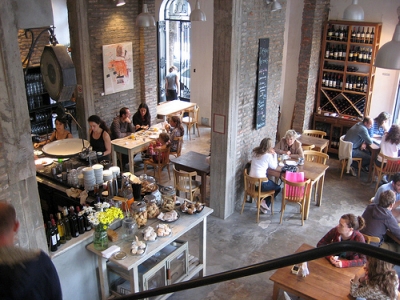
You can admit it, that whole “I’m moving to Buenos Aires to learn Spanish” ruse may work on your parents (who are shelling out the dough for your college education), and your friends back home, but we all know your real reasons, and they likely include food, culture, nightlife, Patagonia-excursions, siestas, and maybe even a few amorous adventures. Nevertheless, you’re there, and you need to improve (or even begin) those Spanish language skills, and dancing at 4 a.m. at a mega-club ain’t going to do it.
For some help, Lonely Planet put together these five ways you can learn Spanish in Buenos Aires. They include the more traditional classroom settings — they highlight Ibero Spanish School — where classroom sizes tend to be in the 3 – 9 range, and 20 hours a week. Of course, private lessons can be obtained, just be prepared to shell out the 50-60 pesos an hour it’s going to take with services like Ñ de Español.
But why not combine that whole meeting cute Argentinians and learning all in one? Even if you have no ulterior motives, Conversation Exchange allows you to practice Spanish in return for just conversing in return in your native tongue. It’s free and a win-win situation. Or try Spanglish, a service that basically drops all pretenses and combines random locals and Spanish learners over drinks in five-minute increments. Come prepared: learn how to say “Can I have your number?” in advance.
The post Five Ways To Learn Spanish In Buenos Aires (And Maybe More . . .) appeared first on The Expeditioner Travel Site.
]]>The post Top Five Things To Do In Buenos Aires appeared first on The Expeditioner Travel Site.
]]>
Originally, I had wanted to come up with a list of the top-five touristy and non-touristy things to do in Buenos Aires and then I realized that: a) that would be a little righteous as everyone´s experience is going to, and should, be different, b) unless you move here indefinitely or are born here, you are going to be a tourist, and c) it´s o.k. to be a tourist. After 6 months, I am no porteña. Still Canadian, thus a tourist.
However, I understand the frustration that some may have when trying to take a picture of some beautiful architecture and the photo is ruined by a sea of sun-hats and people you don´t know. So, at the end of this amazing trip, I decided to share some spots around Buenos Aires that are worth experiencing. Obviously there are always going to be tourists but, perhaps, those kind of tourists that are doing exactly what you plan to be doing: getting to know this amazing city.
Everyday that I was here I thanked my lucky stars to have had an extended stay. But, if someone could only do 5 major things in Buenos Aires, these are my recommendations:
1) Spending the summer Argentina has its perks for those from the Northern Hemisphere, as it is hot, hot, hot. However, most of the porteños flee the city for their summer houses on sandy beaches, which makes for a very different vibe. Although the city is massive and it cannot be fully depleted of its population, foreigners fill the main squares and pack the cafés. If you want an authentic, dirty, grimy, metropolitan vibe, I recommend seeing Buenos Aires in the Fall. The daytime temperatures stay in the 70´s while nights offer a cooler break. The leaves start changing, everyone starts wearing black (which is awesome), and the fall flowers start to bloom. It is absolutely beautiful.
2) Instead of sticking to the most popular barrios (San Telmo, Palermo and Recoleta) roam the streets of barrios like Congreso, Monserrat, Constitucion, Barracas, Almagro, or Once. Many travel books will warn you about the safety of these neighborhoods, which one should always keep in mind when in a new city, but they should be seen and experienced with a cautionary wonder. The barrios feel a little more realistic and you will hear a lot more ¨Che boludos!¨ around. (Translation: ¨Hey, Idiot!¨)
In Congreso, on the corner of Montevideo and Gral. Juan Domingo Peron, there is a restaurant on the southwest corner (whose name evades me at the time of writing). There, you can get down on some delicious chivito set against colorful banners of fútbol teams and pictures of famous Latin American actors. Super-vibin’.
Monserrat has the neatest vibe with all the same cobblestone of San Telmo minus the heavy pedestrian traffic. The architecture is beautiful, cafés packed with locals, and bakeries on every other corner. (Pastry tip: Pepas, medialunas filled with dulce de leche, and churros filled with dulce de leche and dipped in chocolate. So good.)
3) Instead of arranging to see a ¨Tango Show,¨ where they charge you astronomical fees, get down to the Plaza Dorrego in San Telmo for its Sunday night milonga that goes from 8 p.m. – 12 a.m. I´m sure the dancers wouldn´t mind a few pesos for a tip, but it beats any overpriced sit-down show. What´s even better is that you can watch locals (or join) tango the rest of the night away.
For other authentic milongas that charge a $20AR (about $6US) cover, check out La Maldita Milonga (corner of Chile and Perú) on Mondays or Wednesday. These nights, Orquesta Típica El Afronte plays live of which you can dance to. Want to tango on a Tuesday? Check out La Catedral (Sarmiento 4005) and be blown away by the crumbly, cozy couches, old-cathedral (obviously) architecture, and live-band that plays later in the evening
4) Head to the famous Abasto shopping-mall and be entranced by amazing architecture and hundreds of shops. It has a theatre, an entire level dedicated to watching your kids while you shop, cafes, clothes, a Kosher McDonald’s, etc.. . Then head out and peruse the streets of the Almagro neighborhood. Head East on Corrientes or Lavalle towards the Once neighborhood to find wicked deals on fabric, knick-knacks, containers, leather jackets, books, tiaras for your 15th-birthday, boas, that extra suitcase you will need to put all those souvenirs in, etc. . . All for half the price of the typical, touristy shopping districts like Florida.
5) Head to La Bomba at the Konex on a Monday night for a percussion performance that will blow you away. While there, you have the chance to sip, or guzzle, from the plastic cups that hold a litre of beer for $20AR (around $6US). Then, upon leaving, make sure you don’t just jump into a cab. Buy a burrito de carne from the street vendor, find a Kiosco that sells liter bottles of Quilmes, sit in someone’s doorway and consume both products. Take the bus (the colectivo) back to where you came from (or to a place with more beer).
Now that my bags are packed and I´m ready to go, don´t cry for me Argentina, the truth is I never left you. (Whoa, cheese. I know I am no Eva Peron and I definitely got nothing on Madonna or Chantal Kreviazuk. That´s right. Didn´t even think of John Denver.)
By Brit Weaver

About the Author

Toronto born and based, Brit is an avid leisure cyclist, coffee drinker and under-a-tree park-ist. She often finds herself meandering foreign cities looking for street eats to nibble, trees to climb, a patch of grass to sit on, or a small bookstore to sift through. You can find her musing life on her personal blog, TheBubblesAreDead.wordpress.com.
The post Top Five Things To Do In Buenos Aires appeared first on The Expeditioner Travel Site.
]]>The post Let Them Eat Vegetables! (In Buenos Aires) appeared first on The Expeditioner Travel Site.
]]>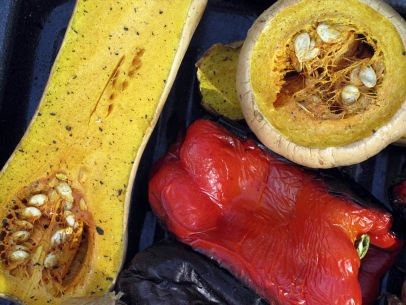
It might not be a part of the European Union, but Buenos Aires has the ambience to contend with the rest. The city has cobbled-stone roads, plazas and cafes on every corner, grandiose hand gestures, and an endearing sense of pride. They take pride in their language, their women, their ability to argue politics and, most importantly, their beef. It is rather difficult to find a spot that doesn’t serve a shoe-sized steak of a quality previously unknown to foreigners.
However, foreigners who have previously committed themselves to vegetarianism or veganism, can find dining difficult in an asado driven metropolis. I was on the border of vegetarianism before I came to B.A. and now am on the border of being completely carnivorous.
For those that feel desire to stick to their leafy-guns, I stumbled upon an article on vegetarian restaurants in Buenos Aires in the NYTimes. This information had to be leaked because, even though the beef is a treat, one’s dietary preferences should not prevent one’s experience of an incredible city.
Most of the restaurants are located in the trendy, modern barrio of Palermo yet are reasonably priced. I am going to venture to a couple of the spots and see if the Argentines can grill an eggplant with as much flare as their bife de chorizo. Empanadas with lemon, pan-charred Swiss cheese filling? I could get down on that.
By Brit Weaver

About the Author

Toronto born and based, Brit is an avid leisure cyclist, coffee drinker and under-a-tree park-ist. She often finds herself meandering foreign cities looking for street eats to nibble, trees to climb, a patch of grass to sit on, or a small bookstore to sift through. You can find her musing life on her personal blog, TheBubblesAreDead.wordpress.com.
The post Let Them Eat Vegetables! (In Buenos Aires) appeared first on The Expeditioner Travel Site.
]]>The post Patagonia, Argentina: What To See And How To See It appeared first on The Expeditioner Travel Site.
]]>
Traveling the South of Argentina can be a bit physically grueling and not easy on the walley. Nevertheless, there are some things that one must see if you travel to the Patagonian region.
San Carlos de Bariloche is a touristy, Swiss-style town with many outdoor activities to work off all the chocolate you consume. Some of my favorite activities were hiking up the Cerro Camponario (take local buses 22, 21 or 10) and riding hybrid-mountain bikes through 25 kms of “good” Argentine roads (potholes are a pervasive part of the pavement’s compostion). There are two companies from which you can rent bicycles (take the same local buses as above) and the hostels are usually able to reserve you one. The buses, or colectivos, cost $6AR pesos and they do give change within reason (unlike Buenos Aires)!
El Bolson is a small, hippie village nestled in the Andean range that is incredibly accessible from Bariloche. Many companies offer seats and the cost is between $20AR and $23AR (between $6US and $7US). While in Bariloche, everyone recommended the town for its trails and artisanal beer. As a result of being the town that grows a ton of hops, there are so many independent beer labels that it would have been impossible to try them all in the few nights that I was there, although I did give it a decent attempt.
I highly recommend hitting up Lago Puelo because of its pebble beaches, crisp water and, overall feeling of absolute tranquility. You have to take the local bus to this out-of-town gem and keep in mind that these buses only run every hour, so don’t miss it!
This brings me to El Calafate, undoubtedly the most expensive town to visit, at least from my experience. The hostels are a little pricier and excursions to the Perito Moreno glacier were a little out of my budget. So, my travel-bud and I made our own excursion: we rented a car. For, essentially, the same price as the bus, we were able to take different roads to the glacier, stop if we wanted to take photographs of random flamingos nibbling, and even check out some other spots around the town.
The price was $250AR pesos (about $80US) for 200 kms and 24 hours. Split between four people (we found joiners on the bus ride to El Calafate), it was almost a steal. However, be forewarned, there is a “cover charge” of $75AR pesos (about $20US) to enter the park where the glacier rests. You have to pay it whether you rent a car, take a bus, or pay $700AR pesos to do a day of trekking on the glacier. What was great was that there are ferry rides that bring you pretty close to the massive piece of splendour, something we tried to do but ended up missing the last ferry ride.
At the end of your stay in El Calafate, buy chocolate. There is a shop called Guerrero on San Martin, the main street, that is small, independent, and has delicious choices of chocolate. I recommend the bitter-chocolate-covered-peanuts. Muy ricos.
In the end, no matter what you end up doing, when you are standing in front of the world’s fastest growing glacier (2 meters per year), it will be worth it. As another glacial tip, many recommend that you see Perito Moreno in January or February as these are the months that the most ice falls. It’s pretty surreal watching a natural wonder shed old layers and the thunderous boom that follows.
By Brit Weaver

About the Author

Toronto born and based, Brit is an avid leisure cyclist, coffee drinker and under-a-tree park-ist. She often finds herself meandering foreign cities looking for street eats to nibble, trees to climb, a patch of grass to sit on, or a small bookstore to sift through. You can find her musing life on her personal blog, TheBubblesAreDead.wordpress.com.
The post Patagonia, Argentina: What To See And How To See It appeared first on The Expeditioner Travel Site.
]]>The post 5 Tips For Traveling By Bus Through Argentina appeared first on The Expeditioner Travel Site.
]]>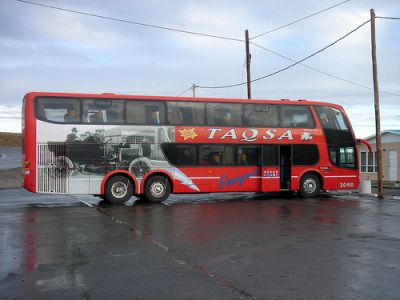
It was a long two weeks in which almost a third of my time was spent on overnight buses. I traveled from Buenos Aires to Bariloche to El Bolsón to El Calafate and back to Buenos Aires, all by bus.
When I arrived in Argentina, I gave no consideration to leaving Buenos Aires. As one of the world´s largest cities, I figured I would have plenty to do. Then I read Bruce Chatwin´s, In Patagonia, a travel classic and absolutely epic account of man´s need to see the desolate Patagonian terrain.
Then I stumbled upon Paul Theroux´s, The Old Patagonian Express, a journey through the region that started in Boston and ended in the desolate, Patagonian terrain. Theroux was a friend of Chatwin´s by no coincidence.
So it was, I decided to make my way to the desolation that is Patagonia. I decided to take the bus although everyone recommended that I fly straight to Bariloche. However, I wanted to see the country and meet the locals, as locals don´t usual have the luxury to fly.
I now believe, without a doubt, no matter what the maps looks like, that Argentina is a big country. Since I took so many buses, I wanted to share some tip on traveling by bus in Argentina:
1) Retiro Station: They do not announce when buses are not coming. I was waiting for my 4 p.m. bus with the company Via TAC. It was my first time on an outer-city bus in Latin America. I was a little nervous, traveling alone and with my mediocre Spanish. However, I pushed through. I waited. And waited. The bus never came and I had to change my ticket for the following day with another company — Que BUS.
2) No soap in soap dispensers — bring some if that kind of thing really freaks you out.
3) My rid on Taqsa — the bus company that has a monopoly on all routes from Bariloche to El Calafate (with various stops to load and unload people — not for food or bathroom breaks) — was easily one of the worst bus rides of my life. I mentioned this before, but I got this ticket thinking that it would be more comfortable than taking the touristy, yet grueling, Ruta 40. I am not so sure anymore.
4) Andesmar Buses are a riot! This bus company goes all over and my experience with them was sheer hilarity. The drivers were blasting ¨Girls Just Wanna Have Fun¨ whenever we made a stop (and yes, there were 100% percent more stops than Taqsa). What they lack in interior design they make up for in great service.
5) Pay the extra 50 pesos for Executive Buses — especially at the end of a long trip when all you want to do is relax and think of your bed. It equals to about $15 American dollars and I consider it an investment for a decent, if not good, night´s sleep. Getting executive-class was not a voluntary decision on my part. There were no more public buses to Buenos Aires from Puerto Madryn and I didn´t care to see any penguins. I don´t regret one centavo.
Nevertheless, I missed the Olympic Hockey game for Gold between Canada and the United States. A no-no for a Canadian like myself. I may be a little disappointed, but Patagonia was well worth it.
By Brit Weaver

About the Author

Toronto born and based, Brit is an avid leisure cyclist, coffee drinker and under-a-tree park-ist. She often finds herself meandering foreign cities looking for street eats to nibble, trees to climb, a patch of grass to sit on, or a small bookstore to sift through. You can find her musing life on her personal blog, TheBubblesAreDead.wordpress.com.
The post 5 Tips For Traveling By Bus Through Argentina appeared first on The Expeditioner Travel Site.
]]>The post Taveling Patagonia Around Ruta 40 appeared first on The Expeditioner Travel Site.
]]>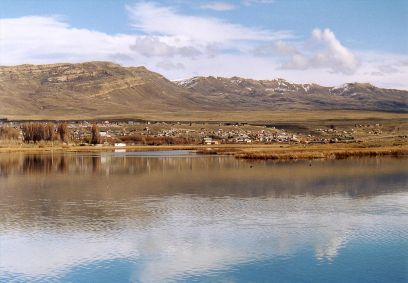
I’m sitting on the bottom bunk of my hostel in El Calafate, home of the famous Perito Moreno Glacier, and exhausted from a days journey by bus from El Bolson, a tiny hippie-town nestled in the Andes. What was exhausting was not the 26 hours spent in a barely reclinable seat, but that there were no stops to stretch my legs nor food given to ease hunger.
Travelers beware of Taqsa, the only bus company that runs from Bariloche through El Bolson to El Calafate without taking the infamous grueling, gravel road and “ultimate experience” that is Ruta 40. Personally, Taqsa did not offer a much more comfortable ride.
Nevertheless, despite what I was told, El Calafate is all the desolate beauty that one conjures when thinking of Patagonia. Desert, mountains, a small lake in which flamingos nibble, and of course glaciers, which we are saving for tomorrow.
I wish I could write more, but the sheer energy needed to manage this French keyboard (my new travel buddy’s computer) only adds to my exhaustion.
Can’t wait to get back home in Buenos Aires, if only for rest and writing.
By Brit Weaver

About the Author

Toronto born and based, Brit is an avid leisure cyclist, coffee drinker and under-a-tree park-ist. She often finds herself meandering foreign cities looking for street eats to nibble, trees to climb, a patch of grass to sit on, or a small bookstore to sift through. You can find her musing life on her personal blog, TheBubblesAreDead.wordpress.com.
The post Taveling Patagonia Around Ruta 40 appeared first on The Expeditioner Travel Site.
]]>